
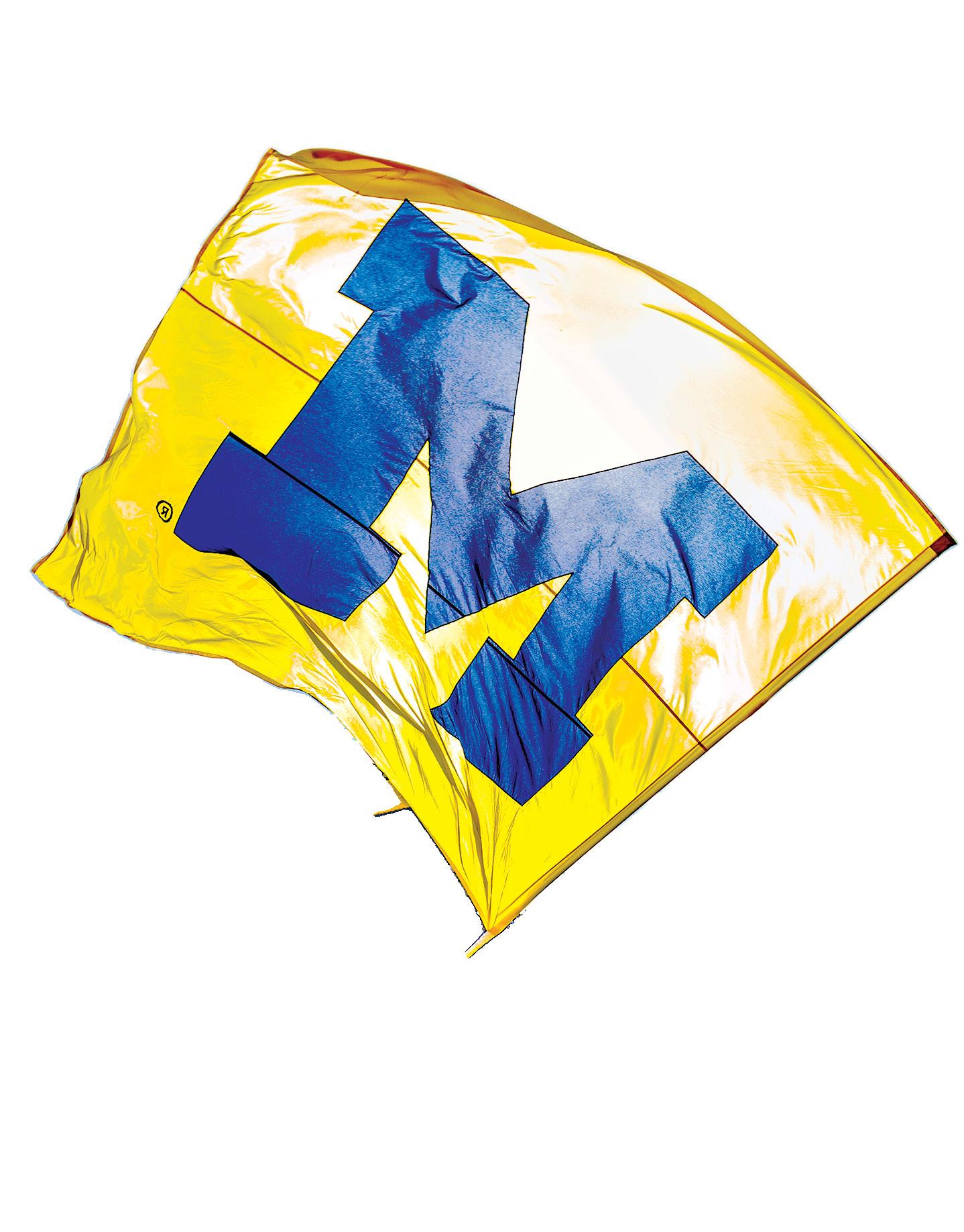
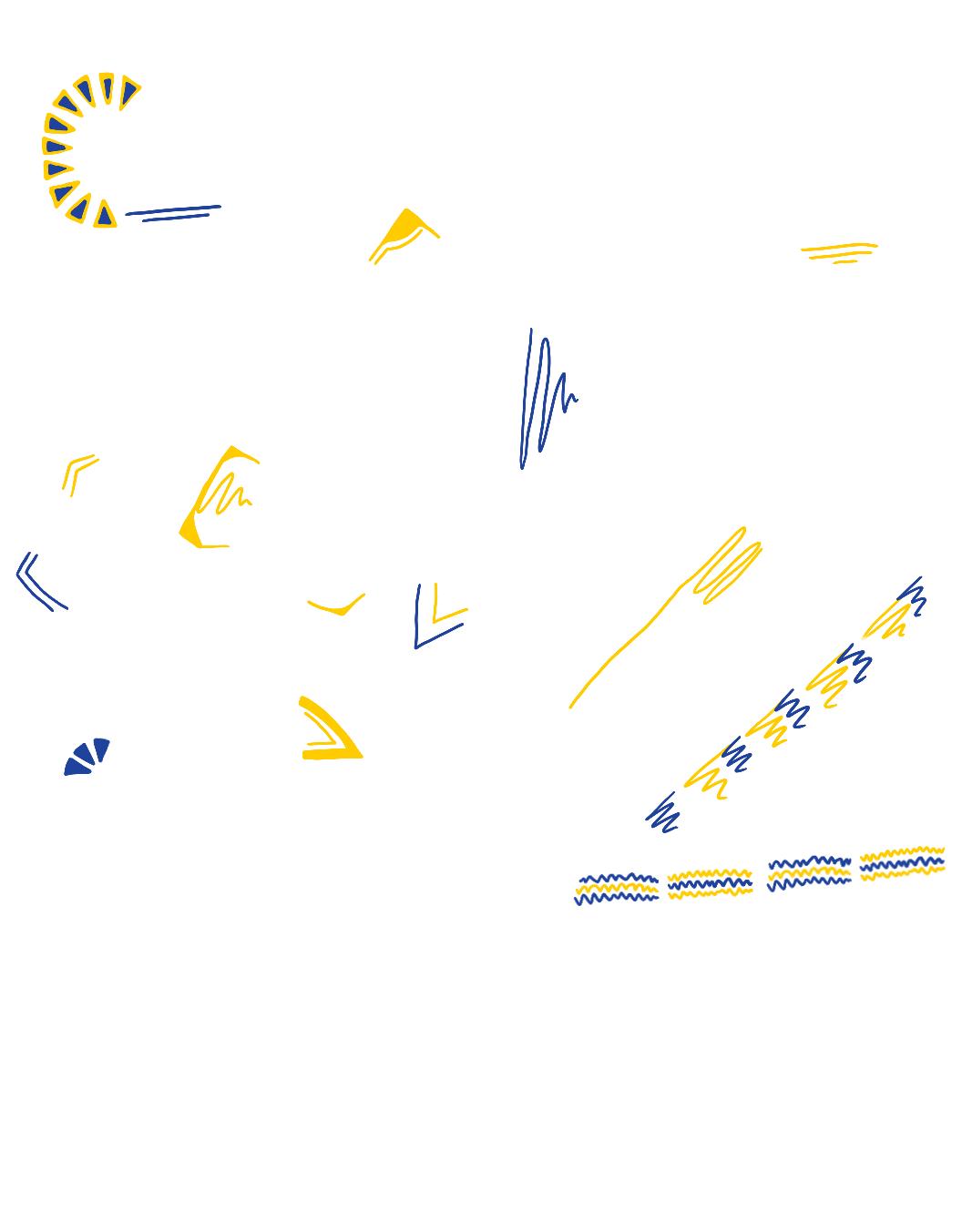

On behalf of the 670,000-plus alumni family, congratulations on your acceptance to the University of Michigan.
From orientation to graduation and beyond, the Alumni Association is here to support you. Discover various programs designed to enrich your academic experience and cultivate lifelong connections, including Welcome Wednesdays, the Forever Go Blue Bash, mentorship opportunities, and more. Begin your lifelong Michigan connection as a Life Member for only $749 – a discount of more than 45% on standard Life Membership pricing.
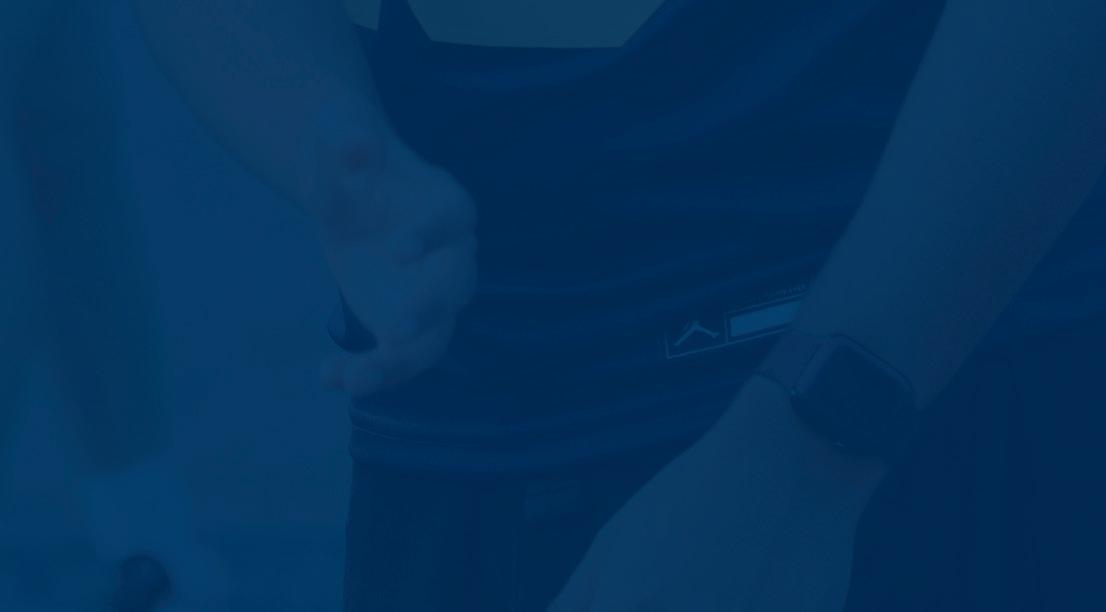
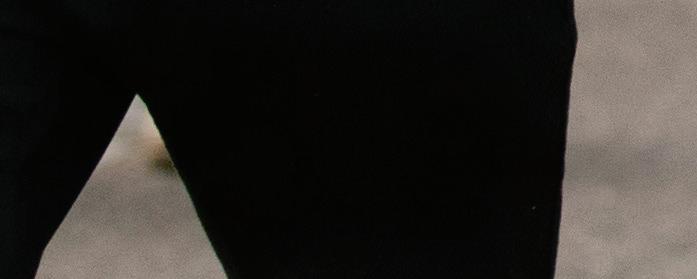


Unlock the power of a Life Membership at alumni.umich.edu/newblue or call 800.847.4764 This is where you belong
2 THE MICHIGAN DAILY
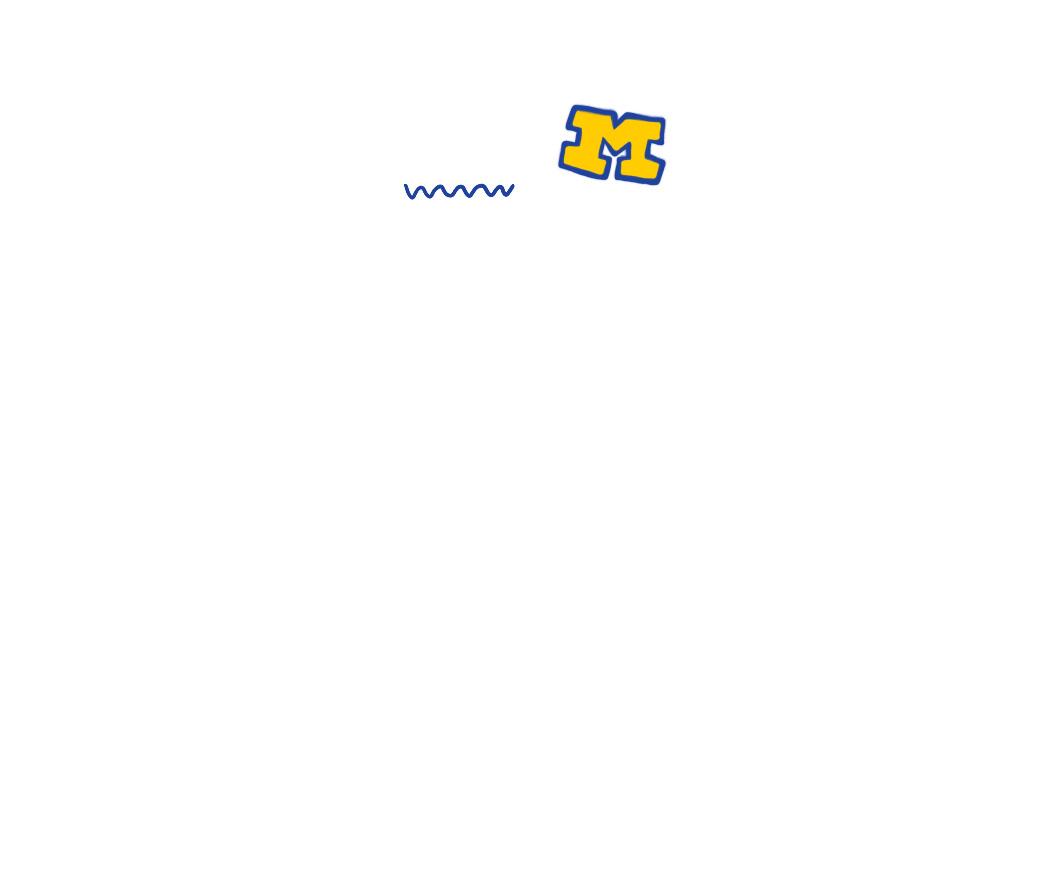 Leyla Dumke
Leyla Dumke
Dear Class of 2028,
Congratulations, you made it! The era of stressful acronyms — GPA, AP, IB, SAT — is finally over. That is, until you have to find where and what the CCCB is. At this point you might be wondering, what’s next? Should you research potential dorm assignments? Reach out to your new roommate? Optimize your fall schedule?
Yes, you should do all of those things. However I would ask you to first sit down, take a deep breath and read The Michigan Daily’s 2024 Orientation Edition.
In this special edition of The Daily, you’ll find advice and tips from Daily staffers about many different topics: scheduling, decorating, walking, problem-solving, sweet treat-ing and more. But the orientation edition is more than just a set of tips; It’s a collection of stories by people who were once in the very position you find yourself in now. Take note of the advice, but pay special attention to the stories. Chances are bits and pieces of them will mirror your own.
When you filled out your application this past fall, you were asked “What community are you a part of?” Regardless of what your answer was then, the day you opened that email you all joined one community — a community of valiant, adversity-conquering leaders. A community of people finding their own definition of victory. A community that The Daily is proud to serve.
You are the next installment in the kalediscopic mosaic of backgrounds that make our community great. This place will change you and you will change it. While you find your own way along that winding path toward victory, know that The Daily is here to inform you, inspire you and aid you every step of the way.
Hail to the Victors.
Zhane Yamin
2024 Summer Editor in Chief
Stanford Lipsey Student Publications Building 420 Maynard St. Ann Arbor, MI 48109-1327 www.michigandaily.com
ZHANE YAMIN Editor in Chief eic@michigandaily.com
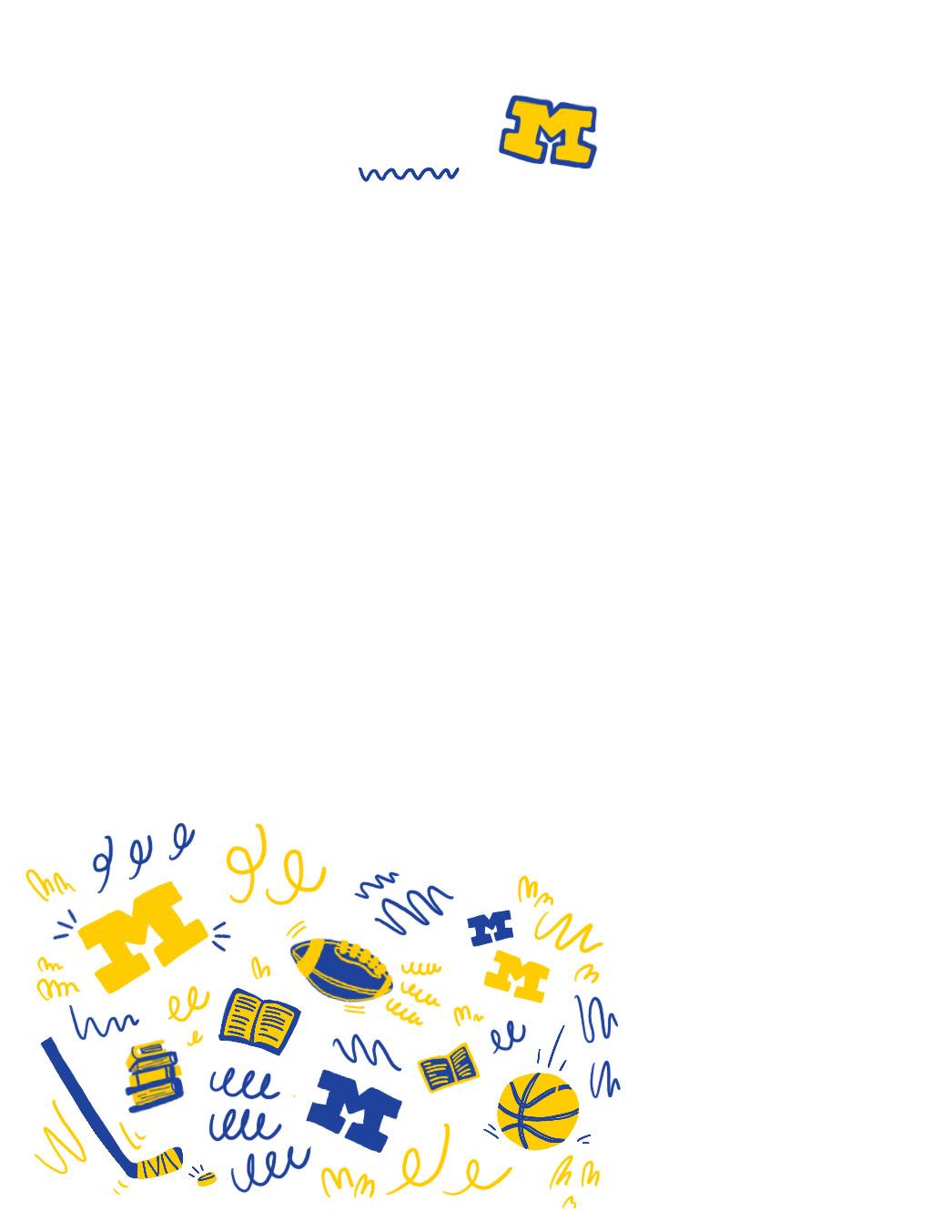
SARA WOLF Business Manager business@michigandaily.com
CONTACT INFORMATION
Newsroom news@michigandaily.com 734-763-2459 opt.3
News Tips news@michigandaily.com
Corrections corrections@michigandaily.com
Letters to the Editor tothedaily@michigandaily.com or visit michigandaily.com/letters
Photo Department photo@michigandaily.com
Arts Section arts@michigandaily.com
Editorial Page opinion@michigandaily.com
Sports Section sports@michigandaily.com
Magazine statement@michigandaily.com
Advertising Phone: 734-418-4115 Department wmg-contact@umich.edu
EDITORIAL STAFF
Mary Corey Managing Editor mcorey@umich.edu
Sneha Dhandapani Digital Managing Editor sdhanda@umich.edu
Eilene Koo and Ellen Drejza Managing News Editors news@michigandaily.com
Jack Brady Editorial Page Editor tothedaily@michigandaily.com
Eli Trese and Zachary Goldstein Managing Sports Editors sports@michigandaily.com
Mina Tobya and Thejas Varma Managing Arts Editors arts@michigandaily.com
Leyla Dumke and Avery Nelson Managing Design Editors design@michigandaily.com
Bela Fischer, Ruby Klawans and Georgia McKay Managing Photo Editors photo@michigandaily.com
Olivia Kane and Liam Rappleye Managing Statement Editors statement@michigandaily.com
Tim Kulawiak and Ingrid Hoffman Managing Copy Editors copydesk@michigandaily.com
Shanshan Ye and Darrin Zhou Managing Online Editors webteam@michigandaily.com
Andrew Herman Managing Video Editor video@michigandaily.com
Nghi Nguyen and Noah Mohamed Michigan in Color Editors michiganincolor@michigandaily.com
Daniel Bernstein and Miles Anderson Audience Engagement Managing Editors socialmedia@michigandaily.com
Nimotalai Afolabi and Fariha Ahmad Culture, Training, and Inclusion Chairs accessandinclusion@michigandaily.com
Madi Hammond Managing Focal Point Editor madihamm@umich.edu
Brad O’Brien Managing Games Editor bradob@umich.edu
3 THE MICHIGAN DAILY
Cover Photo: ALUM ANNA FUDER/Daily Cover Illustrations: AVERY NELSON/Daily Design
by
Embrace the enormity of the University of Michigan
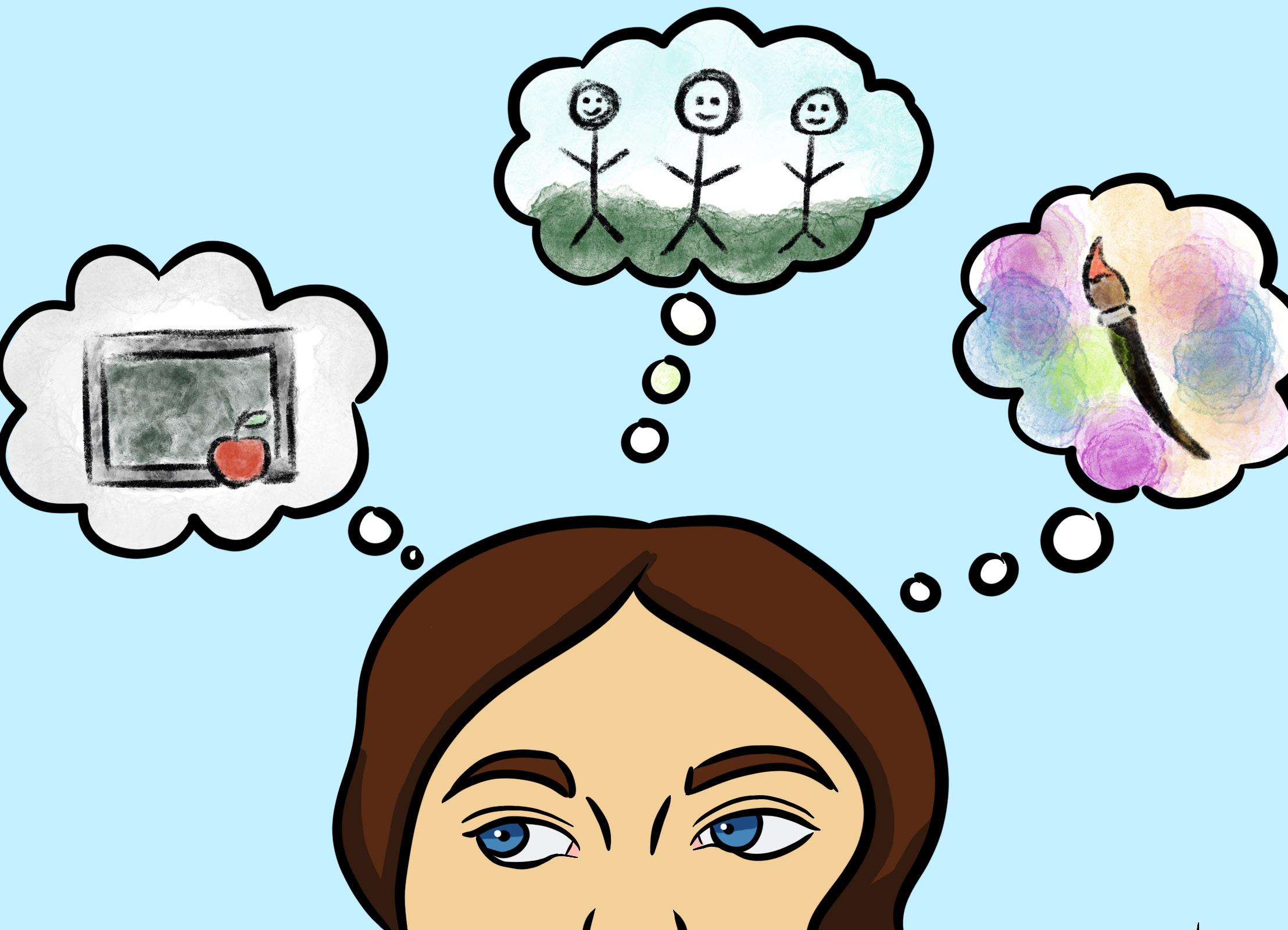
allowed me to find my niche.
One advantage of the University’s size is in academics.
Before coming to the University of Michigan, I constantly heard the phrase “it’s a big campus, but you can make it smaller.” The phrase is supposed to assuage incoming students’ fears that a campus with 33,000 undergraduate students is too big for a student to figure out their place in it. After spending eight months and two semesters in Ann Arbor, I can say that campus feels impossibly big and small at the same time. However, this size has
There are 19 unique schools and 14 of these schools combined offer more than 280 different undergraduate degrees. This variety of schools and degrees within the larger University almost necessitates exploration. Without considering various academic paths, you will not discover your true passions. To help with this, there are school-wide requirements that encourage pursuit of an interdisciplinary education. Once a student finds their passion, they can tailor their
academic path to their wishes, providing them the most fulfilling education possible.
For example, you may realize, through experiences in various humanities courses, that you are interested in a history major. There is only one history major in the college of LSA, but there are hundreds of classes that go toward a history degree. If you choose, you can focus on one region in particular. This can lead to future graduate research opportunities or an acceptance into grad school.
Additionally, having a large number of clubs at the University helps students
find their place by offering a diverse range of opportunities. With more than 1,600 student organizations, you can join organizations that focus on ethnic identity, cultural activities, sports, arts or social causes. This will also allow you the opportunity to form social connections and networks, which will in turn help make such a large university feel more intimate and accessible.
The University’s vast size also contributes to an extensive and influential alumni network that spans across the globe. No matter where you go upon graduating, the
4 THE MICHIGAN DAILY
NATASHA ELIYA/Daily
GABE EFROS Opinion Columnist
alumni network will provide you with a sense of community and support no matter where you go. Alumni connections can open doors to job opportunities, mentorship and profes -
and a sense of belonging, which are crucial for a fulfilling college experience. The large student population also limits personalized guidance from faculty and advisors, leaving students
This variety of schools and degrees almost necessitates exploration. Without considering various academic paths, you will not discover your true passions.
sional growth — creating a “family” of Wolverines worldwide. This powerful network fosters a sense of belonging and continuity, ensuring that Michigan graduates are never truly alone as they navigate their careers and lives.
While the University’s size offers numerous academic programs and clubs, it also means that you may take longer to find your niche. The sheer volume of choices can be overwhelming, causing decision paralysis and making it harder to commit to a particular path. Navigating such a large campus and extensive course catalog can be time-consuming and a little confusing as an incoming student, delaying your progress in finding your passion. Additionally, the competitive nature of joining popular classes and clubs can lead to frustration and feelings of exclusion. This can hinder the formation of meaningful connections
to fend for themselves more often. It might be tough to manage leaving home, newfound academic rigor and a possible part-time job.
While the University’s vast size and extensive offerings can present challenges in finding one’s niche, these attributes also provide unparalleled opportunities for exploration and growth. The initial overwhelm can give way to a rich and fulfilling educational experience as you navigate the diverse academic programs and numerous student organizations. Despite the potentially competitive nature of popular classes and clubs, the University’s extensive resources and opportunities ultimately foster an environment where students can discover and pursue their passions. With determination and proactive engagement, you can overcome the initial hurdles and carve out a unique path at the University of Michigan.
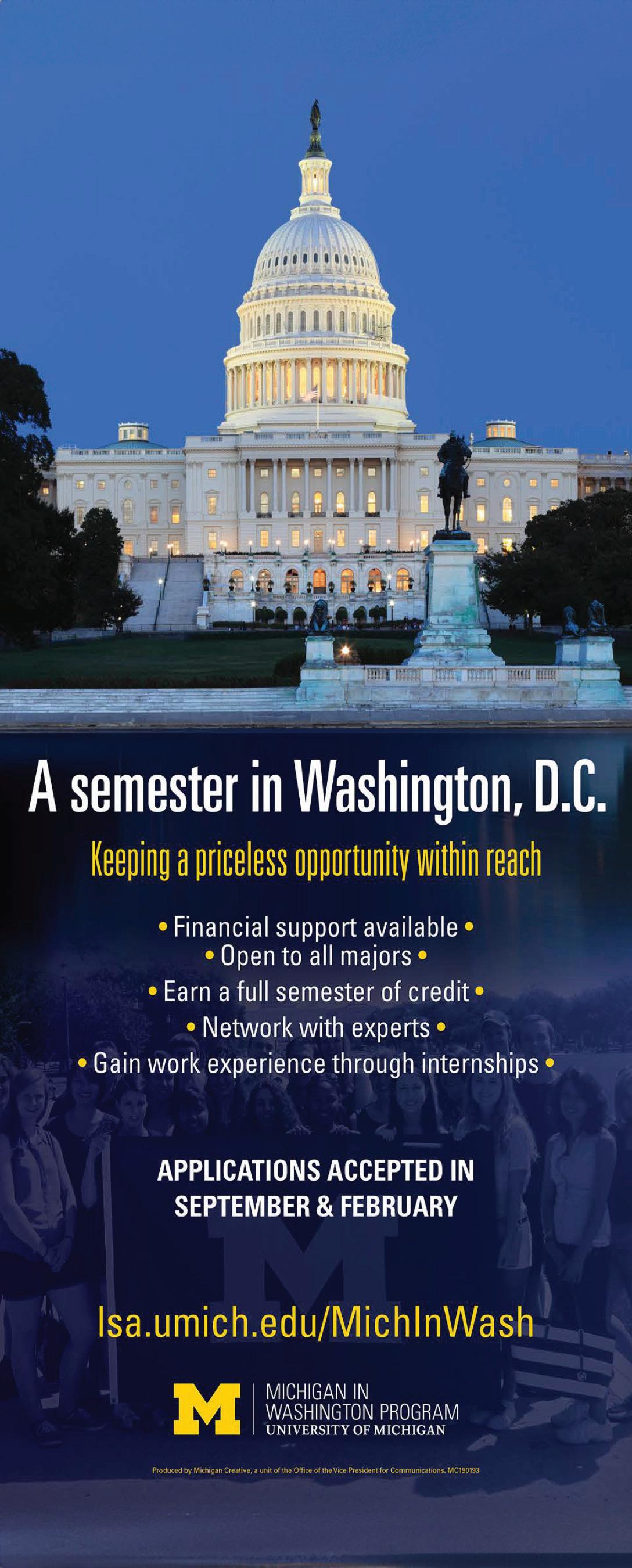
5 THE MICHIGAN DAILY
Dorm Data: The Numbers Behind Freshmen Living
DANIEL JOHNSON Daily News Data Editor
Each year, The Michigan Daily conducts a freshman survey to ask first-year students a variety of questions about their new experiences at the University of Michigan. Between time spent studying, roommates and sex lives, nothing is off the table. For the 2024 orientation edition, we took a second look at the data collected from 685 respondents in last year’s survey to focus on one of the biggest transitions for a first-year college student: life in the dorms.
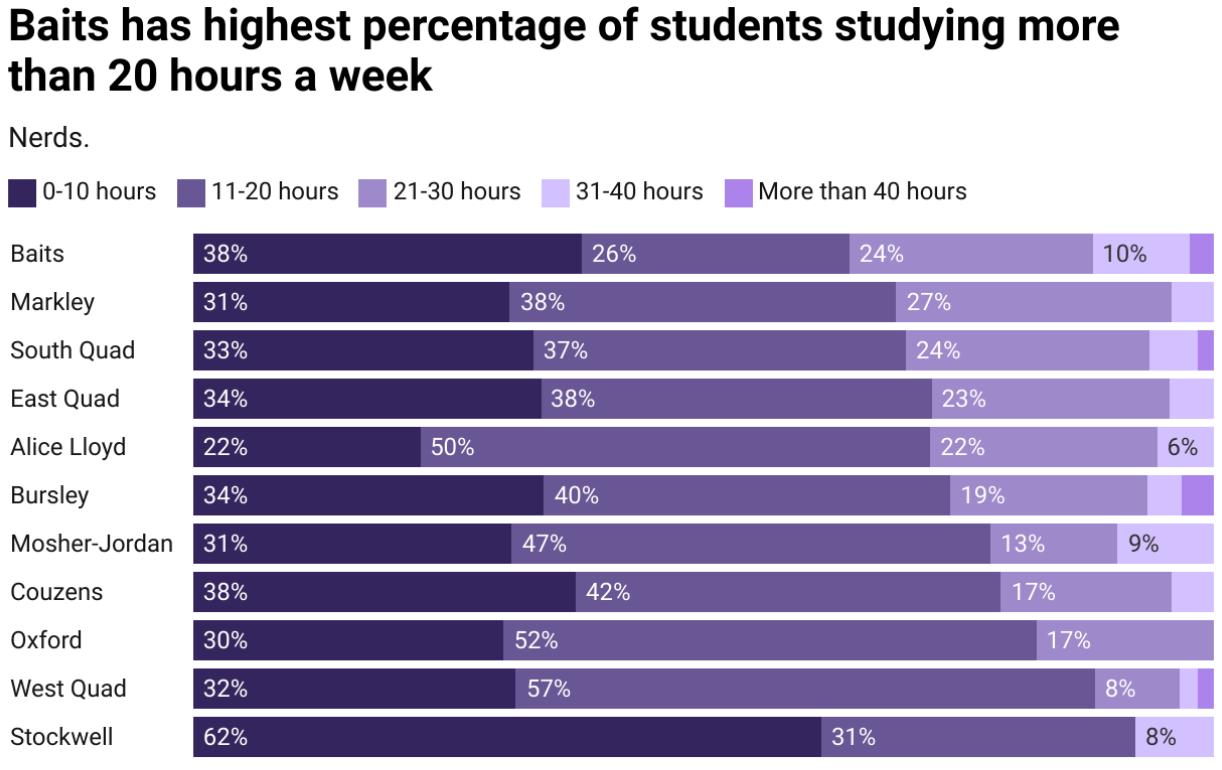
The never-ending quest for a roommate
During the summer before freshman year, one of the biggest questions on students’ minds is about finding a roommate. While some match with people they know from high school, others search for new options on social media, and some cross their fingers and hope for the best from random assignment.
Mosher-Jordan and East Quad have the most randomly matched roommates by far, with three- fourths of respondents from both dorms having never known their roommate before college. Markley and Couzens are the only dorms to have more roommate pairs who matched through social media, an increasingly popular way of finding a roommate with shared interests, than pairs who were randomly assigned.
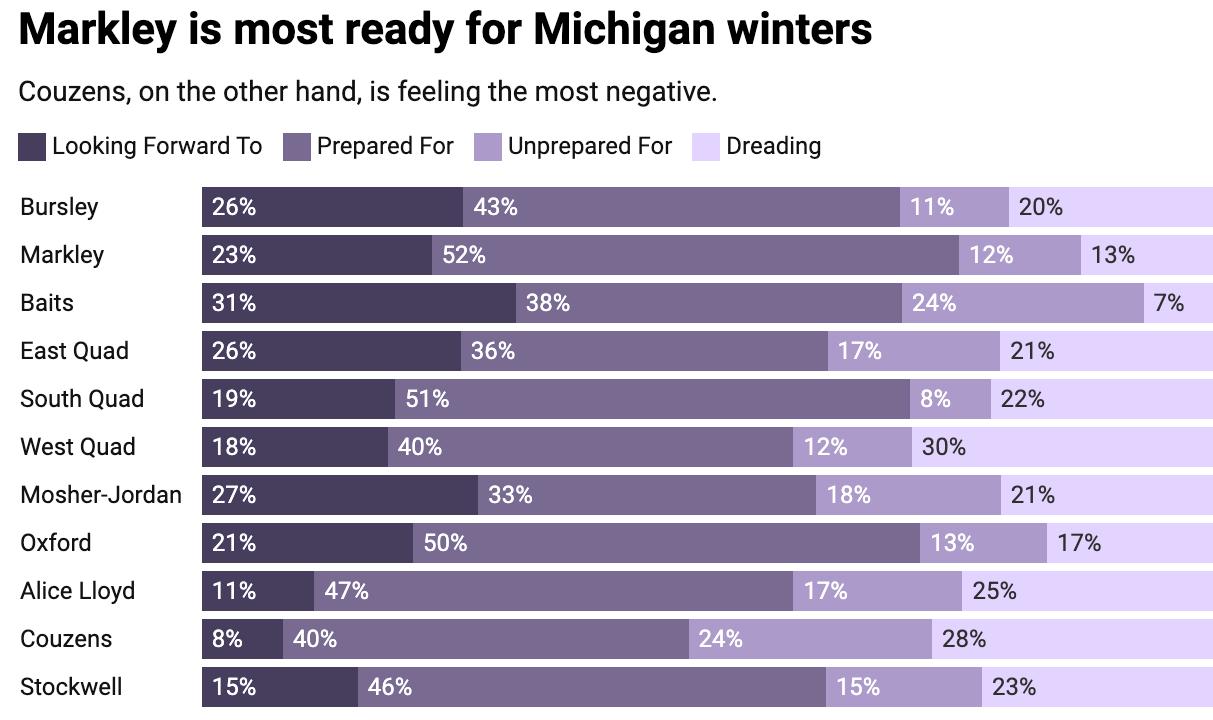
Classes, studying, tears
Workloads vary widely across Michigan, and for the most part, the dorms reflect this variety. Though the differences are slight, Baits took the prize (or maybe the loss) for the highest percentage of students (36%) studying more than 20 hours a week.
Stockwell breaks from the pattern, with almost two-thirds of respondents spending less than 10 hours a week on schoolwork. 8% of respondents from Stockwell studied more than 20 hours a week, and no respondents spent more than 40 hours a week studying.
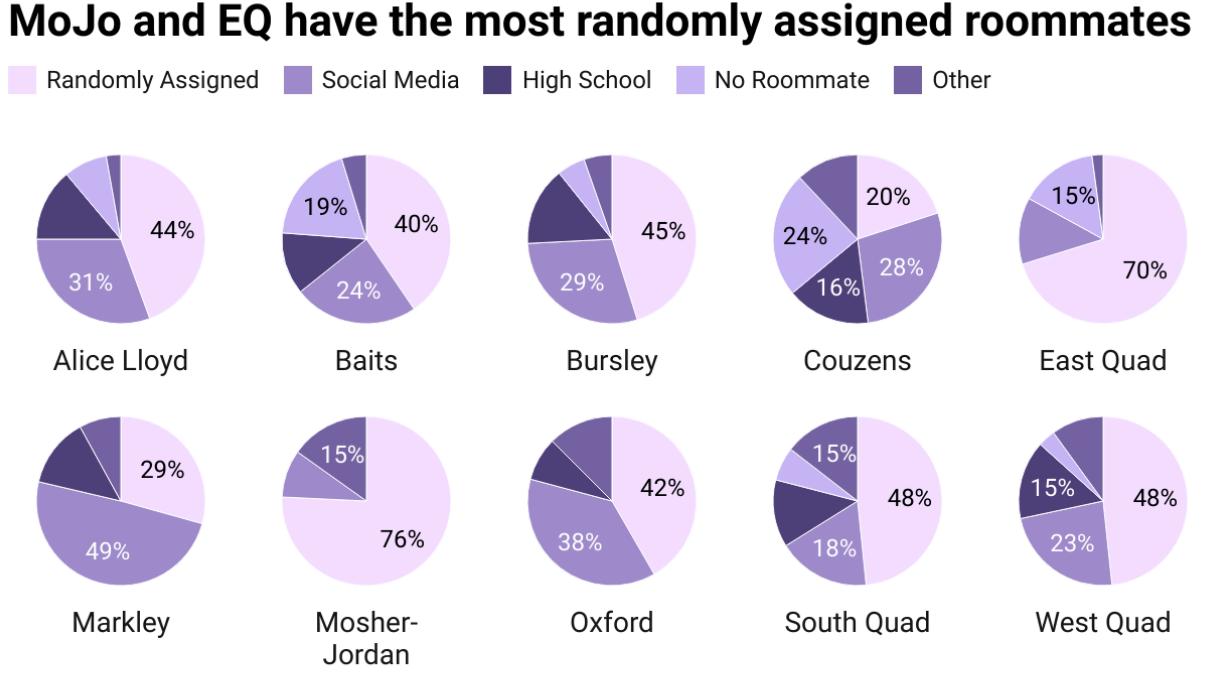
Michigan weather is no joke, but it draws mixed opinions from new freshmen. While walking through campus on a snowy day, a student might see multiple people stopping to take pictures of freshly fallen snow, and students ducking their heads and shuffling their feet as quickly as possible to get indoors. All University dorms have heating, a welcome break from the cold as the temperatures drop.
Some dorm residents are more ready than others. Survey respondents were split on how they felt about the upcoming Michigan winter. Couzens had the most students feeling unprepared for or dreading the winter. Markley had the highest percentage of respondents looking forward to or prepared for winter weather.
DANIEL JOHNSON/Daily
DANIEL JOHNSON/Daily
6 THE MICHIGAN DAILY
DANIEL JOHNSON/Daily
Cold, so cold.









7 THE MICHIGAN DAILY
A GERMANIC
STAND OUT BY LEARNING A SLAVIC LANGUAGE Dutch German Swedish Polish Bosnian Croatian Serbian Czech Ukrainian Russian For more information visit: lsa.umich.edu/german For more information visit: lsa.umich.edu/slavic
LEARN
LANGUAGE
Know your major, know yourself
LINDSEY SPENCER Summer Opinion Columnist
When you started the college application process, you took a whole slew of factors into consideration. You looked at where the school is located, its football team’s statistics and the variety of student organizations it has on campus. Despite these fun and seemingly inconsequential characteristics, one thing tends to come out on top when selecting your university: the possible majors you could pursue.
Through its 14 different schools, the University of Michigan offers nearly 300 different major programs. You can study anything and everything here, from cellular and molecular biomedical science to social theory and practice. With the chance to mix and match majors, minors and sub-majors to your heart’s content, the possibilities seem to be endless. Here at the University, you can craft an academic experience that both perfectly encompasses your personal interests and pushes you closer to your desired future career.
You’ve got time, though, to decide what you want to study. It isn’t required that you come into your freshman year with a concrete plan in mind for your major. Most people declare their major in their sophomore year after several semesters of general education courses and prerequisite classes. With so many options to choose from, you may need this time to “test the waters” of potential paths. But, I’d advise you to jump in head first.
When I applied to colleges, things like good sports teams and a vibrant social scene were certainly on my list of requirements.

However, what came out on top was how the school fared for my desired major. I knew pretty early in my academic career that I wanted to study political science, and the U-M program was an easy pick because of its high rank and professional opportunities. Knowing what you want to study allows you to select the best program possible and an academic environment that will help you grow, thrive and make crucial connections.
Not only does knowing your major help you make that fateful senior year decision in high school, but it also helps you make frequent, fast-paced scheduling choices during college. Course registration is a stressful experience, especially when you don’t know what classes to take and what they count toward. However, if you know what your major will be, you can focus your scheduling needs toward particular departments and requirements.
In my first year, I knew many freshmen who took the strangest combinations of classes. While they may have made these schedules under the impression that it would give them inspiration about what major to pursue, the diversity generally confused
incredibly interesting classes, all without the stress of having to “ace” them for their major requirements. Coming in undecided also lets you take a semester or two to get a grasp on what you want to study without the pressure of sticking to a particular academic or professional course. Being undecided doesn’t mean you don’t know what you’re doing: You’re exploring your options, a perfectly normal introduction to your newfound independence.
them. Without consistency and a clear-cut path toward a singular degree, they floundered in the sea of possibilities and took a much longer time to find their academic niche than other students.
Being certain about your major when you enter college not only saves you lots of academic and personal woe, but it also opens up professional opportunities to you early. The search for a summer internship is not for the faint of heart, especially when you’re unsure about what field you hope to find a career in. However, when you have a good grasp on what you want to study, you can get a head start on looking for work. If you come into your freshman fall knowing you’ll be studying English, you can feel secure knowing that you might be looking for publishing internships. Knowing that you’ll be majoring in biology lets you take the lead on hunting for research or hospital-related gigs. When you know what you want to study, you know what you want to do. There are, of course, upsides to coming to college undecided. My friends who took a “random” assortment of courses pre-major declaration got to take some
Still, there is an immense value to knowing your major once you set foot on campus. You can save yourself lots of stress during the registration process, and join niche, major-adjacent student organizations that can propel you to even greater heights. Making connections — whether they be with peers, professors or professionals — becomes a much easier ballgame when you know your major, and you can begin building yourself a community of like-minded, similarly-oriented individuals.
If you’re coming to the University this fall and are still wavering on what to study, I encourage you to ask yourself the tough questions to save yourself an even tougher ordeal later on. Ask yourself what classes you enjoyed the most in high school or what careers intrigue you, and even read through the major and minor options that the University has to offer. It may feel like you’re confining yourself to a box, but I promise you that you aren’t. As someone who came in knowing what I wanted to get a degree in, I can assure you that I have taken my fair share of unrelated course material to my selected major.
THE MICHIGAN DAILY Read more at MichiganDaily.com 8
ANNA DEYOUNG/Daily




9 THE MICHIGAN DAILY

10 THE MICHIGAN DAILY
‘Where are you from’ and other
questions: Rantings of an Ann-Arbor native
MARY COREY Summer Managing Editor
“So, where are you from?”
This question echoed throughout campus during the first few weeks of my freshman year. Whether it was in orientation groups, discussion sections, frat basements or wherever else I went in the early weeks of the fall of freshman year, I couldn’t escape it. Often sandwiched between “What’s your name?” and “What’s your major?”, this question seemed to be a mutually agreed upon prompt for all introductory small talk at the University of Michigan.
Personally, I dreaded it. My answer wasn’t some sort of exotic, far-off state that sees sunshine for more than three months of the year or the topic of love songs and poetry. I grew up an approximately six-minute drive from my freshman year dorm room, and during my first few months at the University, I was determined to hide the fact that I was going to college in my hometown.
Ever since I started thinking about college, I insisted to anyone and everyone that I was going to an out-of-state school and getting as far away from Ann Arbor as possible. As I finalized my college list at the end of my junior year, I filled it with fancy private schools on the East Coast, pretending that I didn’t see my mom’s brow furrow at the price tag attached to what I considered the ticket to the life I wanted to lead. Famous journalists or writers or politicians or artists or poets didn’t go to big state schools down the street from them; they lived their college years making a name for
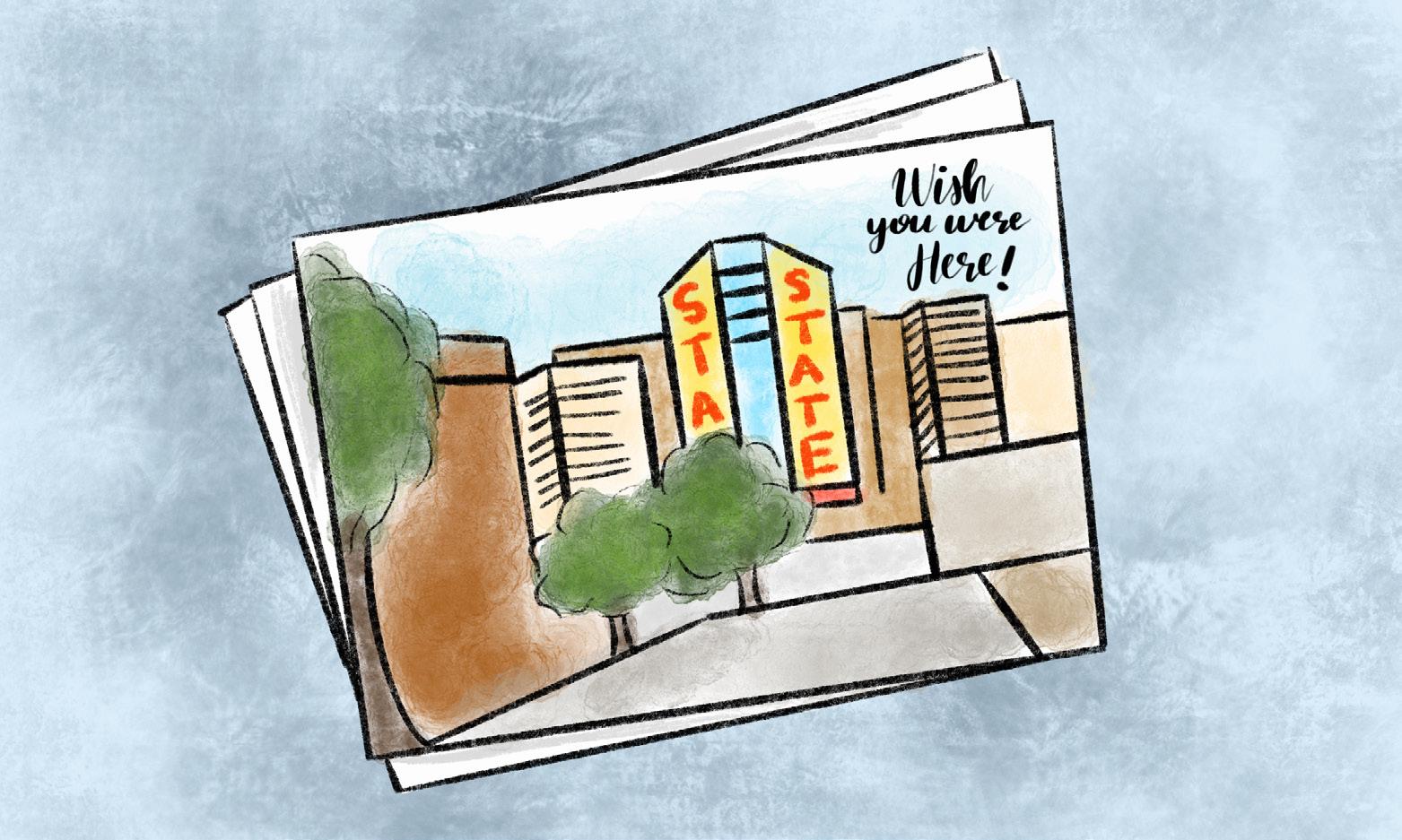
themselves in fancy apartments in big cities.
As my college decisions and financial aid packages rolled in, I reluctantly put my deposit down at the University of Michigan, feeling disappointed that I wouldn’t get to experience a new college town in the fall. After I allowed myself a few days of pouting, I decided that I was going to make the best of my spot at this school that plenty of other people would gladly take.
Throughout my first semester, my resolve to reinvent myself proved stronger than my inevitable homesickness, and I avoided going home as much as humanly possible — only making the short trip back for holiday breaks and the one time I had the flu. I made new friends from all around the world and found new favorite coffee shops, avoiding the places I frequented in high school. My efforts to convince myself that the distance from my parents was further than it actually was had proven surprisingly effective. If I
tried hard enough, the sidewalks I walked down to get to class weren’t the same ones I have been wandering my entire life.
With more than half of each U-M graduating class coming from within the state of Michigan, I imagine many of you might be feeling similarly. Whether it’s a city in Southeastern Michigan or a small town in the Upper Peninsula, going to college close to home can feel like a setback during a time you are supposed to be prioritizing new experiences in new places for the first time. But, it doesn’t have to be.
Throughout my first two years of college, I have realized that, although I am still in the place I have always been, I am nowhere near the same person. When I tried to convince myself that I was somehow “stuck” going to college in Michigan, I accomplished nothing but holding myself back.
As a highschooler growing up in Ann Arbor, I convinced myself that I already knew the ins and outs of college life at the University
NATASHA ELIYA/Daily
and my college experience would bore me — since apparently I was already such an expert. I couldn’t have been more wrong. From within campus, life was nothing like I had expected from my lens looking in. If I could go back in time and talk to myself from two years ago, I would tell her to open up to this opportunity that might be a blessing in disguise.
I grew up in the same house my mom grew up in. From kindergarten to senior year, I sat in the same classrooms and read the same books as my grandparents did. My Ann Arbor roots run deep, deeper than I would like sometimes. As someone who is obsessed with the idea of fresh starts and has had an independent streak since I could walk, the idea of going to college in the city I grew up in was not thrilling at first. However, my time at the University has required me to learn to love life as it is, instead of waiting for it to begin.
11 THE MICHIGAN DAILY
Read more at MichiganDaily.com
With great connectivity comes great competition
GISELLE SESI Opinion Columnist
A week into my freshman year, a student asked me, “Do you have a LinkedIn?” Though I had heard of the platform before, I had little understanding of what it was or why I needed a profile. The idea of displaying a public resume to collect connections confused me, but as I became more involved at the University of Michigan, I discovered that such activities are a large part of campus culture — all stemming from the push and pull of competition and connectivity.
It is no secret that the University is a competitive institution. Many consider it highly selective, with this year’s acceptance rate resting at about 18%. For the Fall 2024 semester, the University admitted approximately 18,900 students out of 105,000 applicants. We tend to overvalue the prestige of the institution and the honor of an acceptance, which feeds into enrolled students’ competitive drive.
Competition is the intimidating result of a highly connected campus, but it’s not always a bad thing. Only when they lead to toxic relationships and damage your interactions with others, do competition and connection become dangerous. Thus, when you begin to balance friendships with your extracurriculars this fall, it is important to separate competition in the professional field from your personal life.
Competition is complex in nature. On one hand, it serves as a means to push us to strive for more success. On the other hand, competition can be coun-
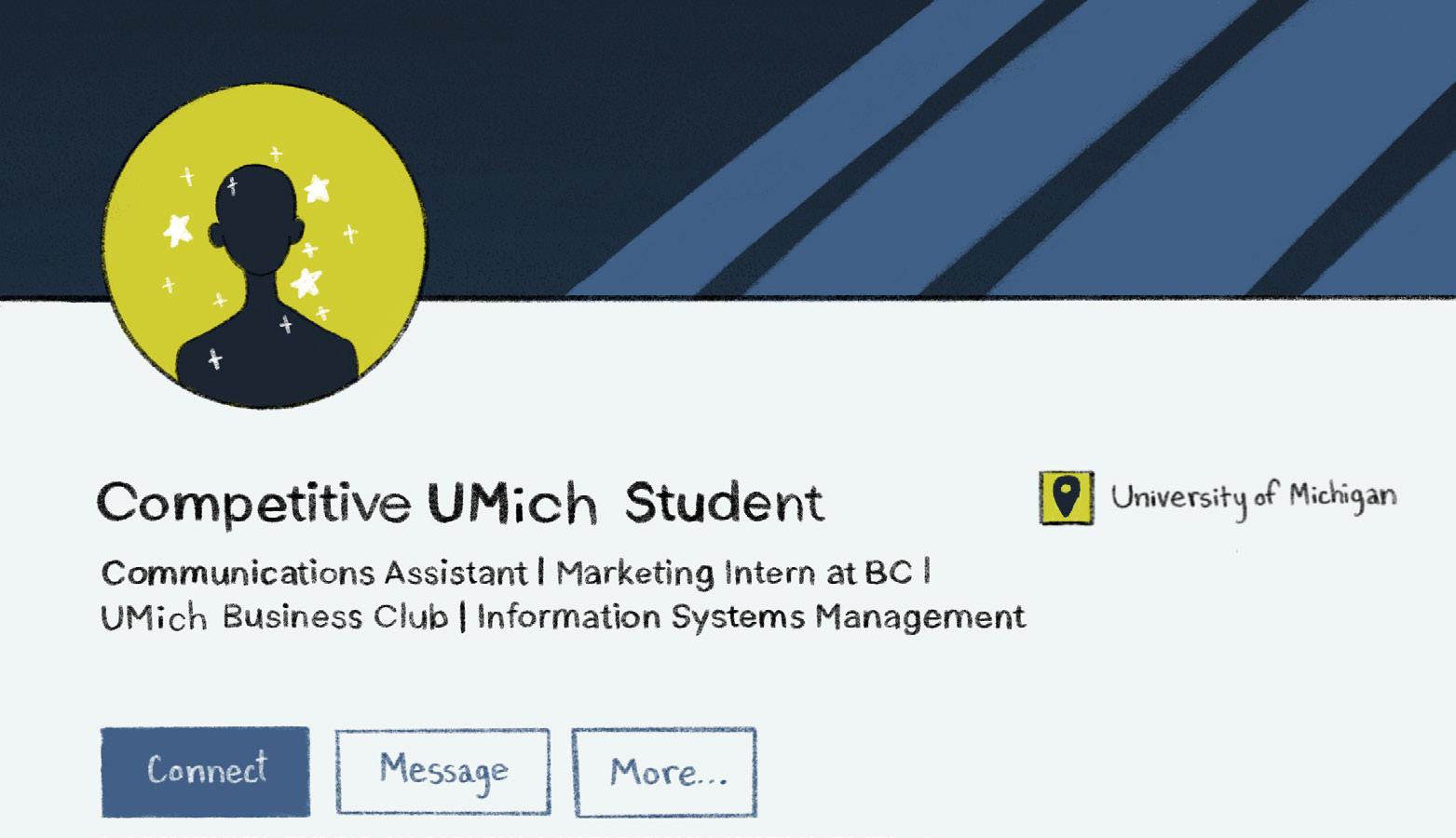
terproductive to connectivity because of its potential to strain relationships and hinder collaboration.
Connectivity can take many forms. Technology enhances opportunities for organizations and employers to spread their influence, but students at the University ensure interconnectedness through non-technological methods as well. As you walk throughout campus, you will see flyers located on the walls inside classroom buildings and handednout by students occupying the Diag to spread awareness about different clubs and platforms.
The beginning of your time at the University will be busy, from getting acquainted with the college environment to participating in Festifall, which will familiarize you with the University’s more than 1,600 student organizations. Like many other new students, you will likely be eager to join at least one or two. Involvement on campus is important, and while there is an organizaiton for everyone, they also lead to
another level of competition on campus.
Many of the clubs have difficult application processes. Some require you to write short essays that detail your passions and identities, and others — like professional fraternities and organizations geared toward post-undergrad life — require you to participate in activities that allow the members to get to know you beyond your writing.
A common misconception is that competition only manifests itself in unhealthy ways. Though it is true that competing against others has the potential to become toxic, especially if it serves as your only motivator, it can also be beneficial. Everyone is at a different place, going at their own pace, with goals unique to themselves. Yes, you should do your best to stand out; but no, you should not direct anger toward people who have just received a new internship or an acceptance into a club.
Although many students are not ill-hearted, there is still an inherent pressure involved when competing against your
EVELYN MOUSIGIAN/Daily
peers for positions that range from club leadership roles to internships. During your first semester, as you start to discover your passions, the competition is not obvious right away. For me, second semester brought on the pressure; my professional fraternity prompted me to finally make a LinkedIn profile and we started to discuss summer internships.
LinkedIn is a platform that allows for effective networking with established professionals and fellow students in order to collect connections that will enhance your opportunities. Individuals can build their profile by posting accomplishments such as newly elected positions or summer internships. The more connections you forge, the larger your network grows, ultimately better preparing you for your future endeavors. This is where the competitive edge comes in — an innate part of our being lies in wanting to be more successful than those around us.
12 THE MICHIGAN DAILY
Read more at MichiganDaily.com
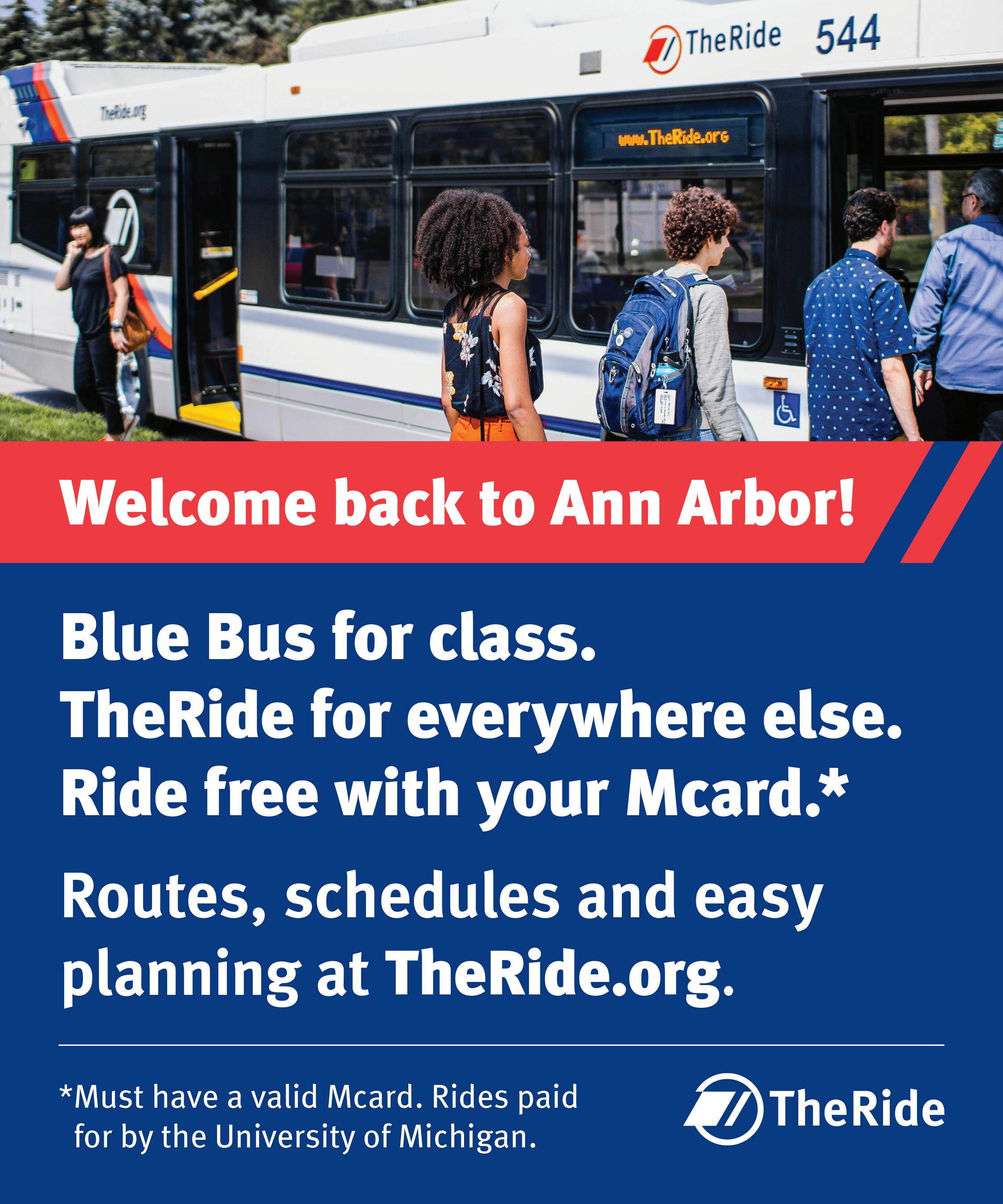
13 THE MICHIGAN DAILY
 EVELYN MOUSIGIAN/Daily
EVELYN MOUSIGIAN/Daily
Burnout will happen
MILES ANDERSON
Summer Managing Audience Engagement Editor
You will burn out. Everyone does. You may think you are stronger than burnout, but, trust me, you aren’t. This isn’t a dig on you as a person. You got into the University of Michigan, meaning you’re likely passionate and driven. But trust me you will burn out, nearly 80% of students report some level of burnout and for 40% it made it hard to even function. The odds are not in your favor.
You may be asking yourself, what is burnout and why is this loser lecturing me on it?
Burnout is a state of mental, physical and emotional
exhaustion brought about from immense stress. I can tell you from experience that your first year in college will be stressful. You will have your mental, social and academic limits tested. You’ll take the hardest classes you’ve ever taken, meet the most people you ever have and be more stressed than you ever have before.
In the fall of my freshman year I thought I wanted to go into medicine. So, I took a STEM heavy schedule to try and get ahead of things and I piled on the early classes to make sure I would get up and get everything done for the day. I thought I could handle it. After all, I had done so much in high school and was able to keep up with anything thrown at me.
As classes started and the reality of a college workload set in I quickly realized that I was kind of screwed. It was only 16 credits, and the average full time student takes between 12-18, but it was stifling. I would spend hours upon hours solving homework problems, trying to read ahead and scrambling around to try and write papers about topics I knew next to nothing about.
I was also doing my best to join new extracurriculars and meet new people. I was going around to just about every organization on campus to see if I wanted to join them. To this day, I’m still on several email lists for clubs I never joined.
I figured I would try a bit of everything and keep doing it. I didn’t — because no one can do
everything and remain sane. I did find one or two that I loved though. One of those was The Michigan Daily; I never wrote for my school newspaper, but I joined The Daily because one of the current co-Editors in Chief yelled at me in the Diag and handed me a sticker. I was also trying to talk to as many people as I could to try and find those lifelong college friends that everyone talks about. It was constantly draining my social battery and not working particularly well.
Moving a million miles a minute to stay on top of everything I had signed up for was difficult to say the least. By the end of the semester I was dead tired and knew that if I continued pushing myself like this for four more
14 THE MICHIGAN DAILY
years I would be a shell of myself. I also realized I actually had no interest in medicine. I just wanted to prove to myself that I could do it, plus I sucked at chemistry which didn’t help. I would likely have discovered this later on in my college career, but because of my burnout I was able to escape from the jail I put myself in and pursue things I actually had an interest in.
By winter semester I had reached more of a balance. I had found a couple extracurriculars to stick with and I was taking classes that were difficult but still enjoyable. I was able to spend more time with the friends I had made in college plus a few from high school. That semester went by mostly without a hitch, but at the end of it I was still exhausted. I had never felt this way after school had ended. I didn’t realize it at the time, but I had been under intense pressure for nearly nine
months straight. I had been facing stress from every facet of my life and I was suffering because of it. My grades were not what I had wanted them to be, I hadn’t made all those lifelong friends I thought I would and I had only found a few extracurriculars. It seemed like I should’ve done so much more, but I think that
vince me that I should’ve done even more despite only making it by the skin of my teeth.
I realize my tale of my freshman year does not inspire feelings of abject horror, but that is how burnout tends to present itself. It is rarely a true rock bottom. It is almost always just a skimming of the bottom and
the chance to learn what you really want to do instead of what you feel like you should do. You can prepare yourself about the high likelihood of burning out, try and know your limits before you’re buried under 12 clubs, 18 credits and a research project. Burnout can hit any time in college, not just your freshman year. Burnout is a part of modern life, it’s important to aware of it and not let it sneak up on you.
would’ve killed me. I had been mesmerized by the infinite possibilities of college and flew too close to the sun by trying to do everything all at once without ever giving myself a chance to reflect and think “Hey maybe I am doing too much.” And here my thoughts were trying to con-

maintaining itself just above so you feel like you can keep going. Burnout doesn’t usually reveal itself until it’s gone. That’s why it’s important to know about it now. You can try to remain mindful of it, and not overextend yourself like I and many others have. Burnout gives you
I can’t stop you from burning out, but that isn’t a bad thing. You tested your limits and found them. Burnout is a new beginning. You can be like a phoenix rising from the ashes of your own exhaustion. Use these moments to figure out the best balance for yourself. It will be different for every single one of you reading this, but once you find your equilibrium you can go forward and do just about anything.


15 THE MICHIGAN DAILY FOR BLUE LIFE! Welcome to the best fan community in college sports. Get in the game with a visit to The M Den for apparel and gear from Nike, Champion, lululemon and more. Stop by one of our locations or shop online any time at MDen.com! The Official Merchandise Retailer of Michigan Athletics
0898-24 - 1/4 page ad Michigan Daily Orientation Ad_V2.1.indd 1 5/23/24 9:06 AM Burnout is a new beginning. You can be like a phoenix rising from the ashes of your own exhaustion.
WELCOME HOME
To decorate a dorm: An art and a journey
CLAUDIA MINETTI Summer News Editor
Growing up, my mom rarely let me put up posters on my walls because she claimed they would ruin the paint. Although I dearly loved the light purple color I had chosen when I first moved into my house, I wanted to hang colorful posters with fairy lights draped over polaroid pictures of my closest friends. In secret (and in an act of rebellion), I hung my first poster in my closet, a picture of the character Thrawn from Star Wars I acquired from the book aptly named “Thrawn”. In my junior and senior year, I slowly transformed my childhood room into a space I wanted to be a reflection of myself. Naturally, my first purchases were fake vines and fairy lights, but I never got around to hanging any posters as I had originally planned. I collected trinkets and polaroid pictures and souvenirs I gathered in a mini treasure cove in the corner of my room.
When I entered my East Quad dorm room for the first time in freshman year, I was excited by the opportunity to decorate an entirely new space and create my own little corner of the world. Within the first days, I started envisioning the type of room I wanted to have. Similar to any entering freshman, I saved every aesthetic dorm room picture on Pinterest to find inspiration.
I could have chosen a minimalist look with the walls white and a potted plant in the corner of my windowsill or I could have made it as loud as possible with bright colors spilling into every nook and cranny until every guest who came in would have to exclaim “She’s got personal-
ity!” A multitude of ideas swam through my mind, but I knew I had the complete liberty and creativity to do anything I wanted.
In search of the perfect posters, I attended the poster sale at the Union. For hours, I was mesmerized by the array of drawings, photographs and prints filling the hall. By the end, my arms were tired from flipping through books of posters, but I eventually carried back five prints of all different types. Ultimately, my room never ended up having a theme. I hung blue-green fairy lights over prints of fairies and cats above my bed. I rested a gnome on my drawer with a sign “BREATHE” next to it. I attached a picture of my favorite youtuber across from my desk, and my windowsill overflowed with succulents I collected from a dorm neighbor. There was nothing minimalist about my room and every corner didn’t have the spark of color I had imagined, but it was a home I had created for myself and I loved it. For me, dorm dec-
orating brought a sense of independence and expressiveness I had never really experienced before.
Over the course of the semester, I made new friends and reconnected with old ones from high school. In that time, I visited lots of dorms and got to see numerous styles of decorations. Some of my friends had posters of their favorite artists while others decorated their beds with pillows of every shade in the world. One friend kept a vine in their room that wrapped around the window that touched a succulent in a pot of a Greek philosopher. Another friend kept her desk full of gifts her family and friends back home would send her while her roommate displayed her favorite albums. What I loved was that not one single person had the same dorm as another. Even when someone’s walls remained bare, their desks held memories from back home or the windowsills revealed a part of themselves one had to simply look for. To
me, these moments perfectly encapsulated what dorm decorating is about. Even if the walls are bare or a person has minimal decorating, those aren’t the details that make a person’s dorm more or less special than someone else’s.
Yes, our rooms can be a reflection of ourselves but they are also a place we carve for ourselves.
Our rooms provide us an opportunity to unwind and sneak under the covers for a late afternoon nap. They give us the space to dance and sing out loud (although not too loud since the walls are paper thin). They provide a place to host late-night gossip sessions with your roommate and a party floor for when your friends come over on Saturday night.
Our rooms are intimate spaces where we reveal parts of ourselves to others, and there is a unique sense of acceptance that comes from doing so.
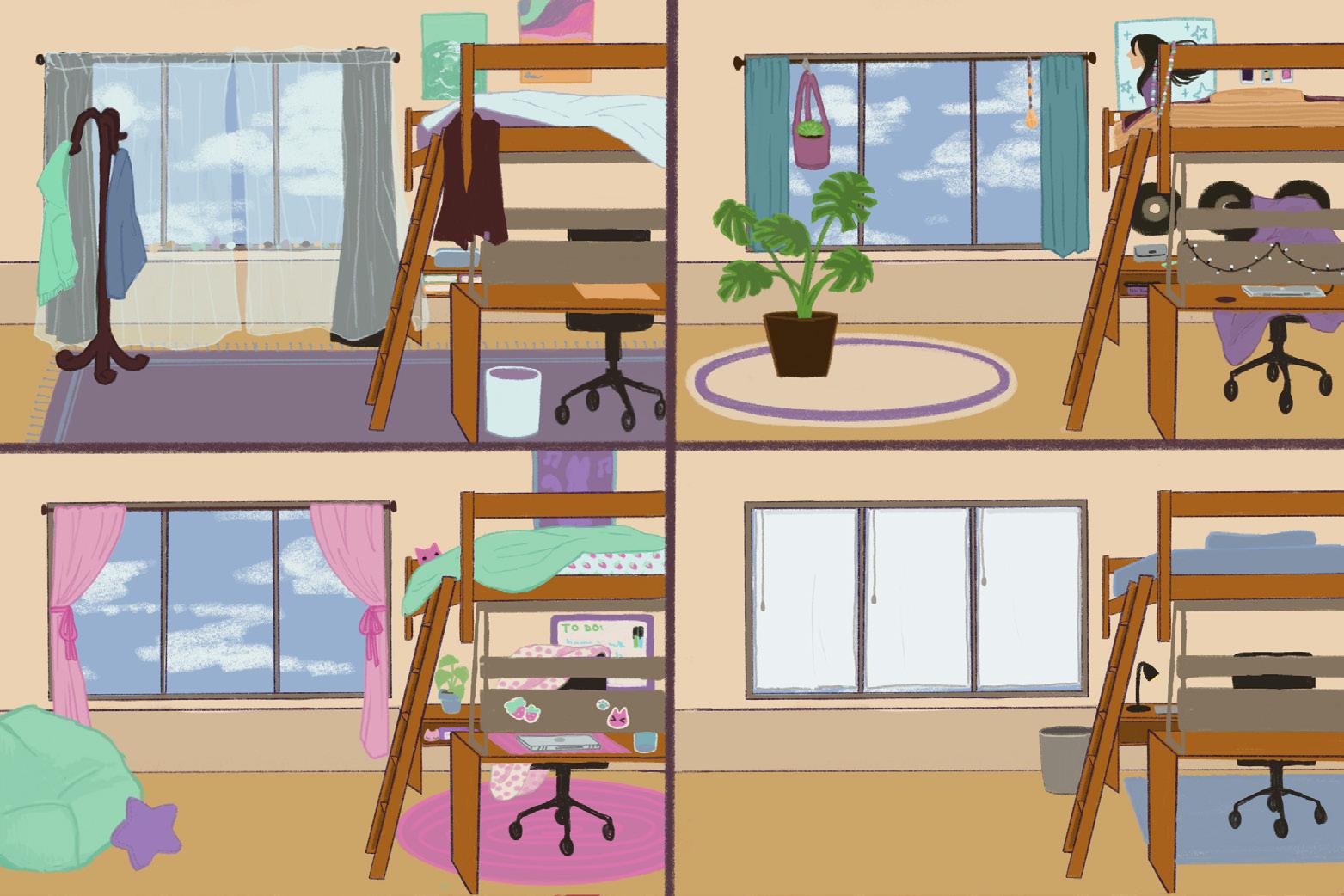
16 THE MICHIGAN DAILY
Read more at MichiganDaily.com EVELYN MOUSIGIAN/Daily
The study app that will let you remember everything
KENNETH SUN Statement Correspondent
What if I told you that you would never have to cram for another test again? That you’d effortlessly remember pertinent information and, moreover, retain it for years after the end of the class? In fact, you could remember anything and everything you ever wanted to.
Introducing: Anki. According to its website, “Anki is a program which makes remembering things easy. Because it’s a lot more efficient than traditional study methods, you can either greatly decrease your time spent studying, or greatly increase the amount you learn.”
Hermann Ebbinghaus’ research on the spacing effect demonstrated that information is better retained with multiple reviews spaced out over time (spaced repetition), rather than in a short burst (massed repetition, aka cramming). Anki, a spaced repetition software, algorithmically calculates the best time to review something. Anki is not the only SRS out there, but it’s one of the most popular and boasts a large active community. Countless others have written guides on how to use Anki like a pro, so I won’t repeat what they’ve said. Instead, I want to share some unique use cases, as well as some general tips and tricks for using Anki.
The first big use case, obviously, is for studying. I am a math and physics major, which are arguably among the least memorization-heavy science, technology, engineering and
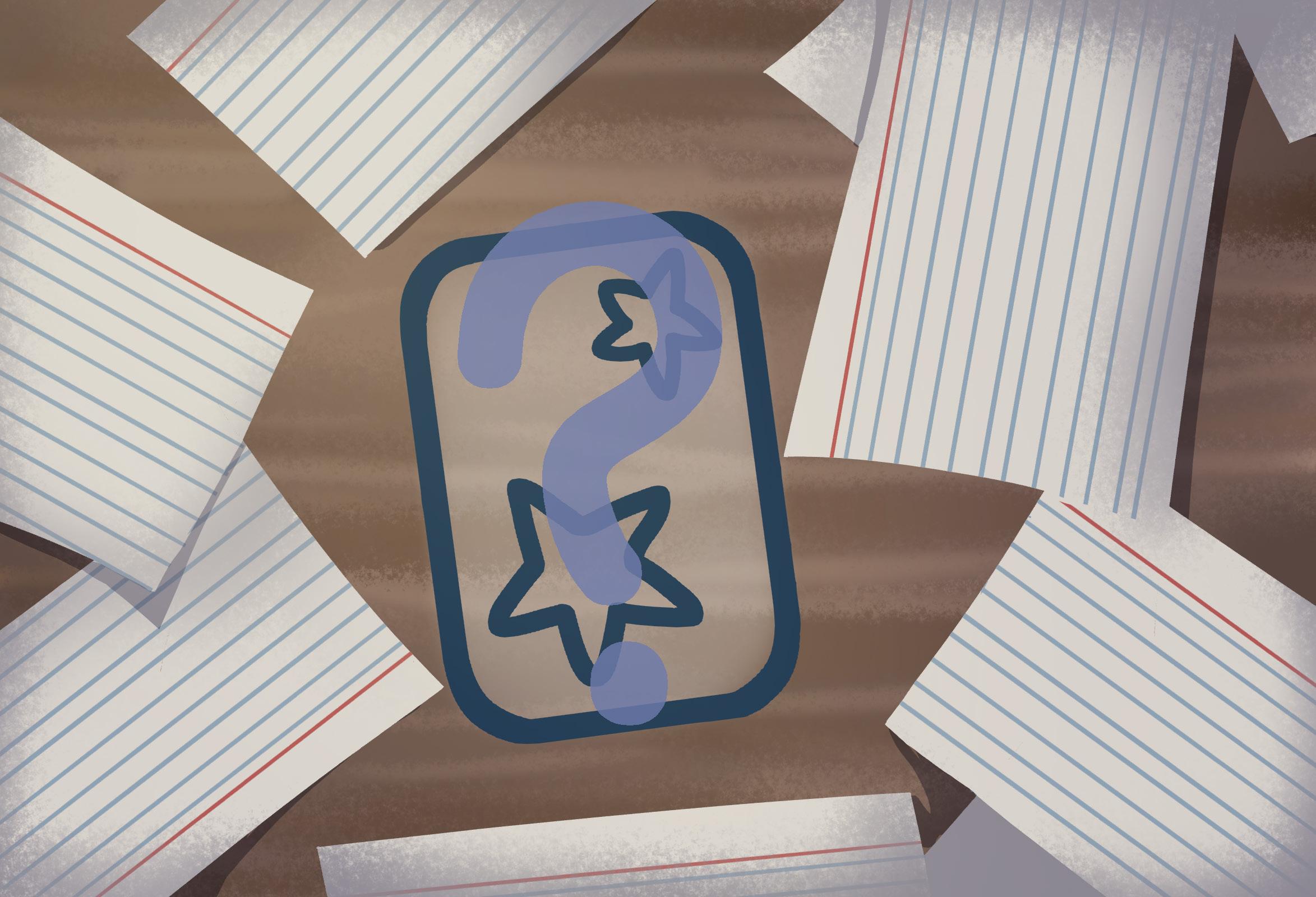
math subjects. In fact, I was once a hard advocate against memorizing equations in physics. I thought the true mark of understanding was knowing it well enough to derive equations on the spot. But intuition has a limit. As deriving everything on exams became both technically difficult and time-consuming, I turned to Anki, which saved me a ton of time studying for my electrodynamics final.
Of course, memorizing something doesn’t mean you understand it. But you can’t understand something that you don’t remember in the first place! Putting a key definition or theorem into Anki forces you to frequently confront the idea, and you’ll naturally try to understand something, if only to remember it better.
Tip #1: Anki has a big collection of add-ons that improve the experience. One of them is an add-on for importing poems
and lyrics. Some other addons I like are Enhanced Cloze, Image Occlusion Enhanced and Review Heatmap (like the Github contribution graph, but for reviews).
Interesting facts: By which I mean any facts, really — whatever you care about, whether you want to know the linguistic history of the English language, random historic events, to recognize birds, cars or classical piano pieces. The possibilities are truly endless. I’ve gotten into the habit of making a note of anything I want to remember in my notes app and entering it into Anki when I have a chance.
Things about people you love: Their birthdays, for instance, or other anniversaries. Sure, you could just as well put these in a calendar, but I think there is some value in caring about them enough to remember them by heart. You could also remember some -
one’s favorite drink or food order.
Tip #2: Anki can help you create reversed cards, so you can, for instance, remember someone’s birthday given their name, as well as recalling their name when you see their birth date.
Geography: U.S. students are bad at geography, and contrary to what the schooling system will have you think, knowing generally where things are is actually a pretty useful skill.
Tip #3: Anki’s official website hosts many shared decks made by other users. Many of them are language decks, but there is also a whole section dedicated to geography. I like the “Ultimate Geography” deck because you can use the filter feature to create custom subdecks depending on what you want to learn.
17 THE MICHIGAN DAILY
Read more at MichiganDaily.com MATTHEW PROCK/Daily

2 TOP-RANKED PROGRAMS
• Elementary Teacher Certification pre-K–6th grade, all subjects
• Secondary Teacher Certification grades 6–12 in endorsement area(s) of your choosing (19 options)
3 PATHWAYS TO CERTIFICATION
• Teacher Education Preferred Admission (TEPA) is a pathway for first-year students to receive guaranteed admission to the professional program in their junior year. Build community, access resources early, and earn scholarships!
• Add a Certification to an LSA degree to expand your career options.
• Multiple Dependent Degree Program (MDDP) earn two unique undergrad degrees from two different schools/colleges at the same time (aka dual degree).
18 THE MICHIGAN DAILY YEARS 1–2 YEARS 3–4 Marsal Education TEPA Scholarship Up to $3,000 Marsal Education Teach Blue Scholarship Scholarships replace subsidized loans and work-study Michigan Future Educators Fellowship* Up to $20,000 Michigan Future Educators Stipend $9,600 *Fellowship In-State only Turn your PASSION into PURPOSE Elementary & Secondary Teacher Education Programs CONSISTENTLY RANKED IN THE TOP 5 by U.S. NEWS & WORLD REPORT TOP 5
Meet with a Recruiter Today to discuss the best option for you! marsal.admissions@umich.edu Education Degrees and Teacher Certification at U-M are Affordable! Available Support: UNIVERSITY OF MICHIGAN MARSAL FAMILY SCHOOL OF EDUCATION
Take easy classes, join more clubs
JACK BRADY Summer Editorial Page Editor
The summer between your senior year of high school and freshman year of college is accompanied by a unique feeling: something familiar is ending, and you only have a very faint idea of what comes next. Your education will no longer be defined by other people. Up to this point, adults have decided your class schedule, telling you when to eat lunch, when to go to the bathroom and when to go home. Leaving that rigidity behind is both exciting and frightening. You’re the adult now — no one calls your parents if you don’t show up to lecture.
Nonetheless, your parents, grandparents, distant relatives and neighbors are probably bombarding you with advice right now. If you’re experiencing anything like I was, you’re hearing something like “College is a great time to challenge yourself” or “Take hard classes to expand your horizons.” Neither point is entirely wrong, but they aren’t entirely right either. College is a great time to challenge yourself and you should expand your horizons, but most of the people telling you this are exclusively referring to academics.
That’s where these self-appointed sages miss the mark. You’re coming to a big school for a reason. Plenty of smaller liberal arts colleges offer enriching, rigorous classes, but they don’t offer the University of Michigan’s more than 1,600 student organizations. You have a cornucopia of extracurricular options before you.
Take advantage of this opportunity, even if that means taking a lighter course load in the beginning. Chosen wisely, the clubs you participate in can prove even more valuable than your courses.
Maybe you’re interested in journalism, like me. Although the University doesn’t have a journalism school, it does have the fifth most visited student publication in the country. My time writing and editing columns for The Michigan Daily has taught me to think more critically and express myself more eloquently than any of my English classes have. Alternatively, you might be interested in public speaking. Preparing and performing jokes on stage with the Amateur Hour stand up comedy club has taught me more about public speaking than any communications
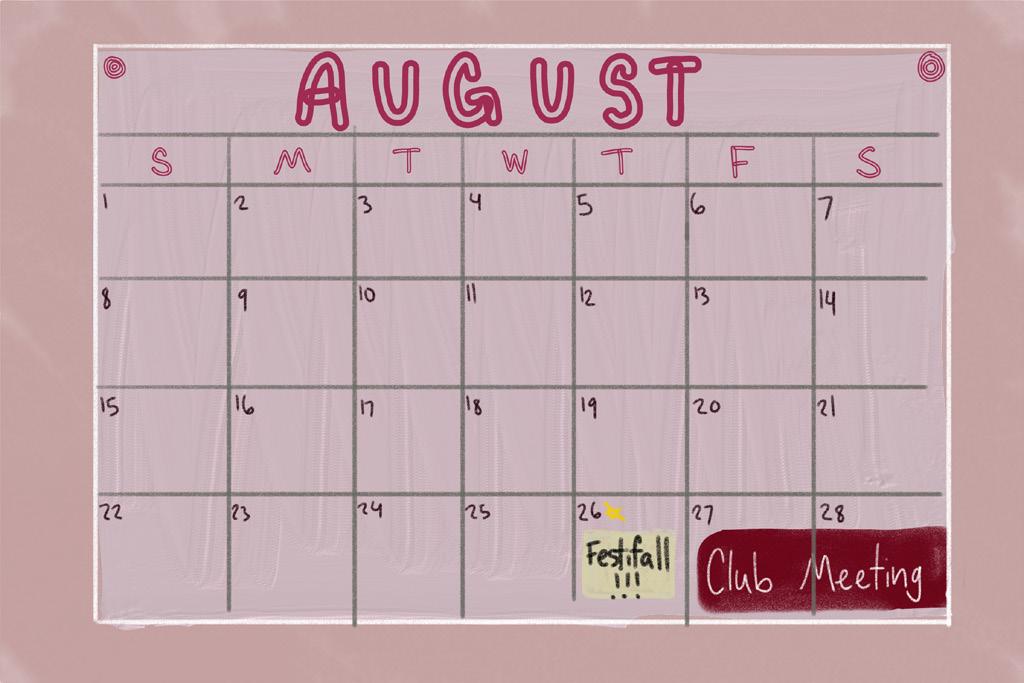
My clubs turned me into who I am today, and I’m eternally grateful. I’ve learned, made friends and even landed professional opportunities because of them. But they take effort and time — time you won’t have if you overburden yourself with academics. The fall of your freshman year will be busy. You’ll move into your dorm
You can learn just as much in a club as you can in a class, if not more.
course ever could. And, it’s a blast.
You can learn just as much in a club as you can in a class, if not more. The best part is that you can learn in a low-stakes environment. Falling behind in a class can devestate your GPA, but falling behind in a club doesn’t have the same dire consequences. If you need to step back for a week or two, you usually can. Even The Daily, which has higher professional standards than most student organizations, often showed me more forgiveness and understanding with deadlines than my professors when I first started here.
in late August and, from then until winter break, there will be a blitz of meeting new people, establishing relationships and, of course, joining clubs. This is the most rapid period of personal growth and development you’ll experience in all of college. Don’t stunt it with an injection of 18 credits and a weeder class.
Let me give you a tip one my older brother gave to me when I was building my first schedule here two years ago. Visit the Atlas Course Guide, enter the classes you’re considering taking into the search bar and look at the median grade.
ANNA DEYOUNG/Daily
If it’s not an “A,” try to avoid that course. You don’t always have a choice — some majors or departments are more difficult than others — but do your best to make this part of your life easy. You likely can put off Calculus until you’re better established on campus.
College is a balancing act. Academics, extracurriculars and relationships are all highly important, and choosing how you want to spend your time on each can prove challenging. You may even feel you need to sacrifice one to have the others, but you don’t. You can have all three, so long as you don’t let any one thing become too demanding. So if you see your class schedule balloon into something unmanageable, or you worry it will distract you from other priorities, don’t let other people talk you out of dropping classes. Remember, you’re the adult now.
Use that freedom to check out every mass meeting you can. Join clubs like The Daily, Amateur Hour or whatever appeals to you. They don’t come at the expense of challenging yourself and expanding your horizons – they’re necessary parts of that process.
19 THE MICHIGAN DAILY
LIV FREY Opinion Columnist
Freshman 15, working out and staying healthy in college
The summer before my freshman year, I was in the best shape of my life. I worked out five days a week, lifting weights and running multiple miles. I was eating well. I started noticing muscle in places I never had before. Surely, I could continue this regimen in college with no problem, right? Right?
In short, no, I could not. On my first full day in Ann Arbor, I decided to explore the on-campus gym closest to my dorm, fully intending to work out. However, once I got there, I was overwhelmed trying to locate the weightlifting machines. Just as I figured out where to put my bag, my sole hair tie inconveniently broke, causing me to turn around and head back in defeat. I resumed my routine from the summer once I was brave enough to go back, but quickly learned that carving out gym time every single day of the week while trying to balance 17 credit hours, clubs and socializing was impossible.
To state the obvious: Your freshman year of college is a huge adjustment on your body. You’ll be walking a lot more, your diet will change and the Freshman 15, the shorthand description for the weight many people put on when they arrive on campus, is ever-looming. But once you settle in, it’s possible to
stay healthy while in college. Below, I break down how to navigate fitness your freshman year in three digestible steps.
Step one:
Locate the closest on-campus gym and off-campus fitness centers
There are three on-campus gyms: the Intramural Sports Building, the Palmer Field Temporary Facility and the North Campus Recreation Building. The IM Building is located on Central Campus and closest to residence halls in the Central Neighborhood. Palmer Field is also located on Central Campus, but is closer to the Hill dorms. The NCRB, as the name suggests, is on North Campus, and is closest to Baits II Residence Hall and Bursley Residence Hall.
During Welcome Week, take a day to explore the different gyms and how to get there. The University’s bus system — the Blue Buses — can take you to gyms that are further away from your dorm. The Bursley-Baits bus stops at the NCRB, while Commuter North and Commuter South stop at the IM Building. Don’t worry about working out that first week when you get to college. I guarantee that taking a week off, especially during a major transitional period, won’t negatively impact your progress.
Each gym is slightly different, but they all offer more or less the same amenities. All
facilities have weightlifting machines, cardio machines and locker rooms. The IM Building has an outdoor track and free parking for people with cars on campus. The NCRB has a lap pool. Both the IM Building and the NCRB have intramural sports, but Palmer only has workout equipment because it’s a placeholder for the new Hadley Family Recreation & Well-Being Center that’ll open in 2025.
There are also other fitness places close to campus. Soul Cycle, located on South University Avenue, is popular for people who are looking for cycling classes. L.A. Fitness, Crunch and Planet Fitness are also close to campus; the only caveat is that you would have to pay for a membership, whereas the on-campus gyms are part of your tuition, giving you access to them during the semesters you are enrolled at the University.
Step two:
Find a routine that works for you
First, figure out if you are a morning person or an evening person; One is not better than the other. If you like to plan out your day using a calendar or a planner, carve out times for the gym (including how long it takes you to get there!). As you’re planning out times, figure out what kind of exercises you will be doing on each particular day. Weightlifting, cardio, intramural sports, dance class, pilates — the options are limitless. No
matter what you do, always remember to warm up first. Warm-ups should typically last between 5 and 10 minutes and help stretch out key muscles you’ll be using later.
Classes and club fitness events are nice because they have a set start and end time. When working out on your own, you’ll get a feel for how long your sessions should last. Personally, I like to keep my lifting sessions around an hour (including warm-up and cool-down), doing five to six different exercises for three to five sets each, increasing the weight up to 80% of my max. Depending on your goals, cardio can be done for 15 minutes after a weightlifting session (recommended for people who are lifting and want to bulk) or on a standalone day for however long you want (recommended for people who are lifting and want to cut).
Try to avoid the busy times (4 p.m. to close) if you can. Anywhere during the middle of the day where people usually have classes (11 a.m. to 1 p.m.) and the early morning (6 a.m.) are typically less crowded.
Bringing a friend can also help reduce gym anxiety, especially if you’re new to the fitness scene. Even if you are experienced, bringing along friends can help motivate you to push yourself and attempt harder exercises. I found that once my friend started tagging along with me during my early morning lifts, I didn’t skip leg day as often.
20 THE MICHIGAN DAILY
Step three:
Eat and sleep!
While I put this as step three, eating properly and getting enough sleep arguably should be your first priorities if you want to see significant progress. Yes, dining hall food is not going to taste like a home-cooked meal, but your body still needs fuel, and ramen will not cut it.
For weightlifters who want to bulk, protein is the most essential for muscle growth. What I appreciated about MDining is that they have
nutrition facts for every single meal. While the portions were on the smaller end, you can take as many plates as you want (but be careful; some dishes run out fast!).
Some of my personal favorite MDining protein-heavy foods were eggs, sandwiches with extra ham and chicken, and lots and lots of yogurt.
It’s also important to distinguish “good” weight gain versus “avoidable” weight gain. When you gain muscle, you also gain weight. “Avoidable” weight gain is when you increase your body fat per -
centage, such as the Freshman 15. Good news: the Freshman 15 is a myth. Although freshmen typically gain weight in college, the average is only 2.7 pounds. However, most weight gain in college can be attributed to empty calories, such as soft drinks, sugary snacks and alcohol, which increase body fat. The best way to avoid empty calories is to be mindful of what kinds of foods you’re eating and how often you’re eating (never skip a meal!).
It’s true that college kids don’t get as much sleep as
they should. But dear reader, if you made it this far, I trust that you have the intention of staying as healthy as possible in this new part of your life. If you’re working out, your body needs “good” sleep (deep sleep) to facilitate muscle growth. College is hard, and if you expect to get away with doing everything last minute, you’re in for a rough one. If you’re getting tired but still feel the urge to study, it’s better to sleep instead.
Best of luck with your fitness journey, and Go Blue!

MATTHEW PROCK/Daily 21 THE MICHIGAN DAILY
Your guide to an Ann Arbor sweet treat
SNEHA DHANDAPANI
Summer Digital Managing Editor
Whether it’s a well-deserved break from a long study session or after a night walking around town, nothing is more rewarding than a little sweet treat. A sweet treat run is the best way to forge new bonds while learningto navigate your new home. While you embark on an eventful year, remember to take the time to treat yourself, whether that be with a group of new friends or on your own.
For the moment when you need a break from Mojo cookies or South Quad soft serve, here is a list of sweet treat options sure to satisfy both your need for adventure, and your sweet tooth.
For a classic adventure — Washtenaw Dairy:
Washtenaw Dairy has everything you need in a sweet treat run: a long walk, prices that won’t hurt your wallet and an incredibly generous scoop of ice cream. Even when I’ve needed to trek across campus to get there, I’ve never once been disappointed in Washtenaw Dairy’s service, small-parlor feel and the large scoops of high-quality ice cream. You’ll find free Washtenaw Dairy donuts all over campus when you first arrive (another delicacy the store is known for), but I highly recommend more than one trip to indulge in the best ice cream in town.
For the roulette — Dunkin’:
I know this isn’t a classic, but if you’re familiar with Dunkin’, odds are you know every location — just like every drink — is notably different. The first

Dunkin’ in Ann Arbor opened its doors this past January, and a second location even closer to campus is rumored to open soon. East Liberty Street is one of my favorite streets on campus, and when you need a study break and a jolt of caffeine, there’s nothing more satisfying than an iced coffee from Dunkin’ and a walk through downtown Ann Arbor.
For a change in pace — Bakehouse 46:
If cupcakes are more your vibe, Bakehouse 46 is your place. Upon stepping inside the bakery, you’ll be greeted by the scent of freshly brewed coffee and a display case full of cupcakes, with fun flavors like Rockin’ Mojito and Lemon Lust. The bakery also offers mini cupcakes if you’re looking to taste their monthly special or just need a quick sugar rush to get you through the day. Unlike many of the options on this list,
Bakehouse 46 always has a couple empty seats ready for you to indulge in a cupcake and the ambience of a quiet bakery in a busy college town.
For a sweet treat at any hour, anywhere — 7/11:
Next time you find yourself wandering around campus, count how many 7/11 stores you see. I couldn’t tell you an exact number, but I can tell you there are enough to make a sweet treat run to 7/11 anytime and anywhere. And, no matter where you are, what time of day or year it is or how icy the sidewalks are, you can always trade a single dollar for a 7/11 slurpee.
For a scoop next door — Michigan Creamery:
When you’re unwilling to make the trek to Washtenaw Dairy, or when the clock strikes 10 p.m., Michigan Creamery will serve you well. Less than a five minute walk from South,
ABIGAIL SCHAD/Daily
West and North Quad, their State Street location is known for its convenience and quality ice cream. Although the lines stretch down the block the moment the sun comes out, a scoop of Wolverine Tracks or a Lavender Honey milkshake is sure to satisfy even the sweetest of teeth.
For the nostalgia — Frozen yogurt from Amer’s:
As a deli infamous for their açaï bowls and sandwiches, many people are surprised to learn Amer’s also offers selfserve frozen yogurt. For me, the decisions between two flavors and an entire row of toppings evoke a sense of nostalgia and a lot of excitement. Although I’d personally choose ice cream over frozen yogurt any day, Amer’s is never a bad idea. For the times you know exactly what you need in a sweet treat, Amer’s is sure to let you create the perfect dessert.
22 THE MICHIGAN DAILY

23 THE MICHIGAN DAILY
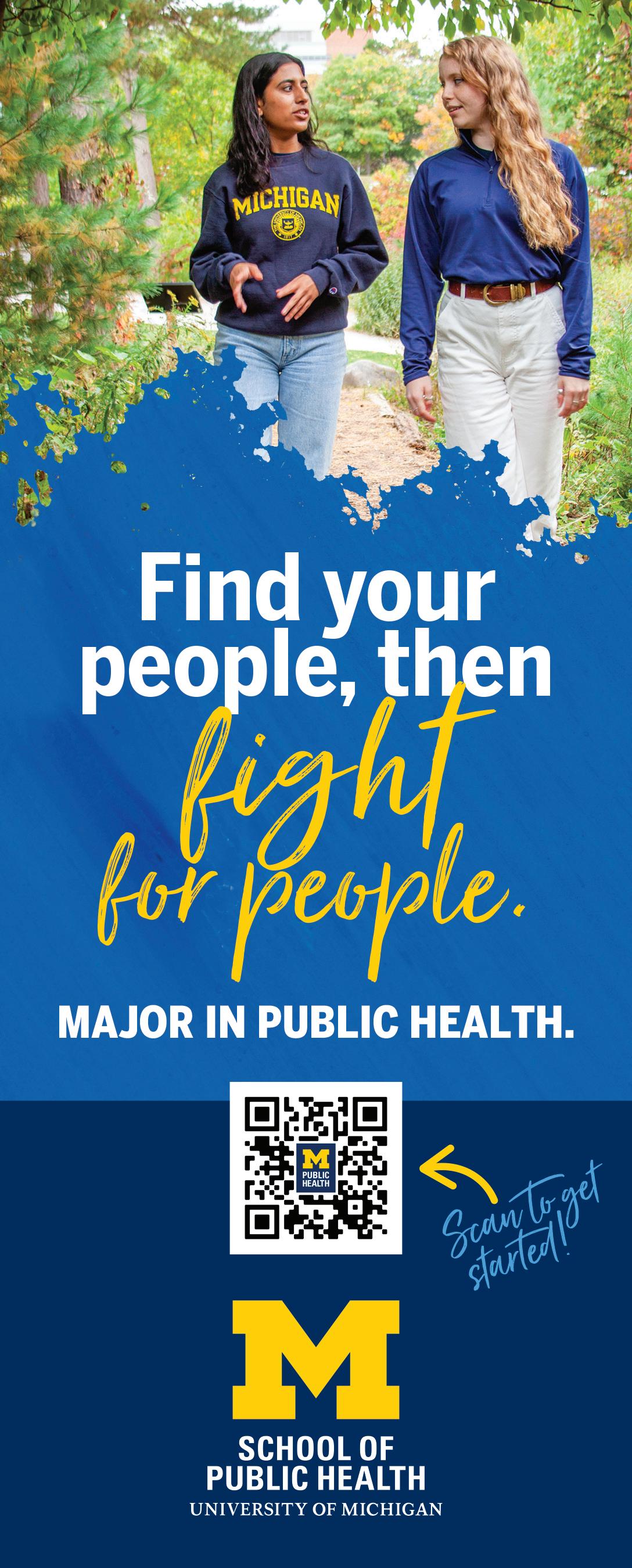
Why you should embrace a liberal arts education
SETH GABRIELSON Opinion Columnist
As a freshman, I was enamored with the predictive power of physics, viewing it as the pinnacle of human achievement. However, my introductory physics course prompted a shift in my perspective. While still intrigued by the subject, I craved a balance between theory and practical application, particularly in aerospace. I was fueled by a lifelong passion for flight and an intense fascination with science fiction. This led me to pursuing a dual degree in physics and aerospace engineering, a path where I could combine theoretical depth with hands-on engineering skills.
During this time, like many freshmen, I was taking my first-year writing seminar. Toward the end of the term, my professor gave what he called his “shameless pitch for the humanities.” Holding a Ph.D. in French literature, he emphasized the importance of the humanities and the liberal arts as a whole, tracing their roots back to ancient Greek thinkers like Plato and Socrates. Initially, I didn’t see the value in including humanities and social sciences in my undergraduate studies. However, about a week later, I discussed this advice with a respected mentor. He pointed out a compelling historical trend: the longer one’s education remains broad and unspecialized, the more prolific you will become.
A brief scan of this history proves this point. Leonardo da
Vinci studied a wide variety of disciplines, from art to science to engineering, even delving into anatomy. In doing so, his breadth of knowledge allowed him to impact multiple fields. Benjamin Franklin’s experiments with electricity complemented his work in natural philosophy. And, through mixing philosophy with his studies in politics, he became the prolific diplomat we know him as today.
Some may argue that focusing solely on science, technology, engineering and math is the most lucrative path, given the high-income potential in these areas and their concerns about the perceived “death of the humanities.” While it’s true that STEM majors often command higher starting salaries and face higher demand in certain industries, education doesn’t have to be an eitheror proposition. By integrating STEM and humanities studies, you can cultivate a broader skill set and perspective. Embracing a well-rounded education that encompasses both STEM and humanities can lead to greater creativity and problem-solving abilities.
Perhaps most interestingly, research shows that when your undergraduate education remains broad, you will earn more in your lifetime, independent of socioeconomic status when entering college. It shows that those with a liberal arts education have a more than 60% chance of landing in the top two highest tax brackets in the U.S.
24 THE MICHIGAN DAILY
Read more at MichiganDaily.com
It’s great to have Plan B courses
KAYLA LUGO
Daily Sports Writer
Since the University of Michigan is a highly-ranked institution, you might think things will run smoothly during your first year. Well, I’m going to tell you that there might be major bumps, and it might be more than simply struggling with what to major or minor in. But, that’s okay.
One of the struggles you may face is your class schedule, just as I did in Winter 2024 when I received some unexpected news. The day before the semester was scheduled to start, my Race and Ethnic Relations course, which was supposed to fulfill my LSA Race & Ethnicity requirement, was canceled. With 24 hours before classes started, I didn’t know what to do.
My schedule, which was meticulously planned to knock out multiple crucial distribution requirements, crumbled as I helplessly read the class cancellation email for the 10th time. I could’ve just waited until spring semester, or even fall semester, to take these classes, but I didn’t want that. The fouryear plan in my Notes app was predicated upon completing my Creative Expression, Upper-Level Writing and Race & Ethnicity requirements by Winter 2024. With my schedule up in the air, I made a virtual appointment with my academic adviser to help find me a plan B schedule. I explained my
dilemma, and she guided me to a resource called the LSA Course Guide. With this at my fingertips, I could view every course offered at the University. So, to find a replacement for my canceled class, I filtered courses to see which ones would fulfill the Race & Ethnicity distribution.
While I already had a busy schedule, with four classes in various subjects, I planned to take a Race & Ethnicity course, and I was intent on sticking to this plan. Since my schedule was so busy, it was hard to find a class to fit into my tightly packed calendar. After searching for what felt like hours, I found a class that was a perfect match — Origins of Nazism. The class met on Tuesdays and Thursdays from 11:30 a.m. until 1 p.m. in the School of Kinesiology Building, a quick walk from my German 102 class in the Modern Languages Building. Additionally, I would still have time for lunch. Without hesitation, I registered for the class.
However, my first few weeks were off to a rocky start because I couldn’t get the required texts in time. hope for the best. Despite this, I did fairly well. I found solace in the professor uploading weekly readings and lecture PowerPoints onto the course site, and actively participating in discussion sections with my classmates. I no longer felt like an outsider due to last-minute registration, but instead I felt like a student who registered for the class in the first place.

25 THE MICHIGAN DAILY
A physics-informed approach to problem solving
ZHANE YAMIN Summer Editor in Chief
As a physics major, it feels like I spend the majority of my waking life solving problems. I’ve calculated the amount of water you get from mixing different ratios of steam and ice, the path of charged particles through magnetic fields and (my favorite) the time it takes for a ball to reach the ground if you drop it from a tall building.
Aside from coming to terms with the fact that I’m a gigantic nerd, I’ve had to confront one question that has persisted throughout my studies: What are any of these problems offering me outside of learning physics and getting my degree? The question isn’t necessarily limited to physics either, but extends to all academic disciplines where you encounter problems. It can be hard to discern what MATH 116’s disk-and-washer method or CHEM 216’s lab practical actually afford you besides a headache and added study hours.
As a freshman, you will come across your fair share of problems. Sure, you’ll have your weekly problem sets and midterms worth 25% of your grade, but most of those will be easy compared to the other problems you’ll face. The new people, new expectations and new experiences Ann Arbor brings are bound to test your limits. Over the course of your time here, you might have career problems, roommate problems, minor problems, major problems and everything in between.
Needless to say, you’ll have some solving to do. Thankfully, all problems — no matter what

domain you encounter them in — have some things in common. For example, they can get pretty difficult, and often require ingenuity, patience and tenacity to solve. But if you have the right approach, they can become much easier. Here’s my own approach to problem-solving. It’s good for studying quantum physics, responding to lengthy emails and a lot of other stuff as well.
1. Read the problem
The first step in solving any problem is to know what the problem is. Despite how innocuous this step may seem, it is often the hardest. Reading a problem on your MATH 115 webwork or on your ECON 101 weekly problem set is easy, but understanding what might be going wrong in your relationships, or within yourself, is much more difficult. In any case, it’s important to listen with more than just your ears. For your relationships, be vigilant about how people feel
and act, and ask yourself why they might be acting the way they are. If you’re stressed, aim to pinpoint what exactly is causing you stress.
This step also requires some implicit humility. You must assume that you don’t know what to do in every situation and admit that there is a problem that needs to be solved. This is scary. But, when you fully confront the uncomfortable truth of not having the solutions, you can start searching for them.
2. Don’t be intimidated
There have been plenty of problems that have scared the shit out of me. In my PHYSICS 360 final, for example, I remember there being a special relativity question that I had no idea how to even begin. After the test was done, I had written effectively nothing down for the problem. I got no credit — not even partial.
No matter how difficult or insurmountable the problem
EVELYN MOUSIGIAN/Daily
you face may feel, you need to at least do something. Partial credit exists in real life. Your problems with your roommate will only grow if you do nothing about them. Likewise, if you find yourself in a difficult class, doing nothing about it will only hurt you (and your grade). You have to initiate that difficult conversation, drop that class or reach out for help. You have to make the leap toward action because doing nothing solves nothing.
3. Take advantage of all resources available.
You will not have the answer to most of your problems. In fact, most of the time, you won’t even know how to get the answer to your problems. So, it’s important to utilize all the resources available to you, to inform yourself about the problem you’re facing and what potential solutions may be. These resources can vary, depending on the situation that you’re confronted with. The
26 THE MICHIGAN DAILY
internet and generative artificial intelligence are helpful, but talking with a friend usually turns out to be a lot more useful (and more fun). You will meet some amazing people at the University of Michigan, even if it takes some time. You will meet people that mirror your every passion, and people that couldn’t possibly be more different from you. These people, their experiences and their perspectives are all unique opportunities to learn more about the world around you and more about yourself. They can be helpful in solving physics problems too.
4. Don’t cut corners
Important issues are not solved quickly. It took almost half a century to experimentally confirm the existence of the Higgs-boson after its theoretical prediction in 1964. While you might not have to do cut-
ting-edge particle physics, the problems you face are likely to be fickle. Approach them with patience and care — and don’t rush them. If your relationship with someone is strained, give
come away a stronger and better person because of it. And when you encounter a similar problem in the future, you’ll know it inside and out. Do the algebra. It’s worth it.
In a way, your time here will be defined by the problems you encounter, not because your degree is predicated upon finishing your homework, but because the problems you solve, and how you solve them, are what define you.
them some time before talking to them. If you’re feeling homesick or lonely, don’t expect the feelings to go away the next day.
It’s easy to use a calculator. It’s not easy to go through five pages of algebra just to reach the wrong answer. Difficult problems take time. But, you’ll find that after dedicating the time to work through these problems, you’ll

5. Take time for yourself
You will experience a lot in your time at the University of Michigan. You will laugh, cry, yell, hurt, hope, suffer, dream and — in the middle of it all — you’ll solve a few problems. It’s important to take time and reflect on your choices: What went wrong? What went right? How can I improve? How can
things get better? You will fail many times before you find the solutions to your problems, but it’s not the solutions that give the problems meaning; It’s your reflections. These reflections not only prepare you to solve similar problems, but also help you along the inevitable path of self-actualization that will begin when you arrive in Ann Arbor.
Problem-solving is more about you than it is about the problem. It’s about learning who you are, how you respond to adversity and how willing you are to grow as a person. It’s also about being optimistic — knowing that a solution exists and doing everything in your power to find it. In a way, your time here will be defined by the problems you encounter, not because your degree is predicated upon finishing your homework, but because the problems you solve, and how you solve them, are what define you.

27 THE MICHIGAN DAILY
Take off your headphones on the way to class

I’m on my way to my first class of the day, and as I’m heading out the door and fitting my AirPods into my ears, I don’t hear the familiar ping indicating a Bluetooth connection. Disgruntled, I pull out my phone to pair my headphones manually, only to be frustrated further by a notice reading “Connection Failed.” My earbuds are dead.
This is an unfortunate yet common occurrence for me, and yet again I resign myself to a silent 10 to 15-minute walk. Over time, however, I’ve slowly come to take solace in my quiet hikes to class. In
between classes, work and study time backed by classical or lo-fi music, I rarely have the time to just exist in silence and take everything in.
I know I’m not alone. Late last year, the “Silent Walk” trend swept through TikTok, encouraging users to take a bare-bones walk — no music or podcasts, only a pedestrian and their surroundings. For those whose walks are often accompanied by a soundtrack, intentionally leaving your phone and headphones behind to simply be with your own thoughts can be anxiety-inducing. Even so, getting over that hurdle and taking in your surroundings, all while staying in motion, makes silent walking one of the better
trends that’s come out of TikTok.
Older generations, of course, have mocked the idea of silent walking — “They think they just invented going out for a walk with no phone, no screens, just to clear your head,” one responding TikToker said. And to some extent, they’re right. Walking just for the sake of it predates smartphones, MP3 players and Walkmans.
What criticism toward silent walking misses, however, is that the Silent Walk is meant to be a solution rather than an entirely new concept. Gen Z is aware of their technology dependencies and is looking for remedies. A technology-free walk, then, is a
much needed challenge for young people to leave behind their technological distractions and enjoy what their city, park or nearest trail has to offer.
When you arrive on campus for your first semester, you don’t even need to designate silent walking time within your day-to-day life. You’ll probably be walking outside every day, but unfortunately, you — like many on the Diag and across campus — might not be walking in the mindful sense. From Weiser Hall to Mason Hall to the Central Campus Classroom Building, we all rush past one another with our headphones on, rarely taking a moment to acknowledge each other
28 THE MICHIGAN DAILY
NATASHA ELIYA/Daily
AUDRA WOEHLE Summer Senior Opinion Editor
and the world around us. We’re missing out on the opportunity to connect to our environment and our community, but the solution is simple: We need to take
acquaintances and making new connections.
Now, this doesn’t mean I’m advising you throw your headphones or earbuds in the nearest trash bin. I
We’re missing out on the opportunity to connect to our environment and our community, but the solution is simple: We need to take off our damn headphones.
off our damn headphones.
I’m someone who enjoys writing, so I’ve come to know firsthand the benefits of a walk — especially a silent one — in terms of creativity. When I walk without the sole intention of getting from point A to point B and instead focus on observing the world around me, I’m able to find new things along the same route I take to and from class. Noticing these small details often helps inspire me, but this doesn’t apply to just writers or creatives. The creative boost a walk provides might help you figure out how to problem solve in your group project or how to approach your problem set.
Beyond creativity, a walk sans headphones can help improve sleep quality and mood, both of which are important for student success. There’s also the social factor to being aware of what’s around you as you’re on the move. When you stroll without headphones, which signify “I don’t want to talk” to the outside world, you open yourself up to greeting friends or
still enjoy going on a walk accompanied by a playlist or the newest episode of my favorite podcast. Headphones become especially handy when I want to avoid chit-chat and be on my way. Still, it’s important to consider what you might be missing out on, from social interactions to the sounds of chirping birds to the fascinating actions of a Diag squirrel.
Really, it’s all about balance. A great set of songs can sometimes put you in the perfect mood on your way to class, but other times, a walk without headphones, whether it’s with friends or just yourself, might be what you need. If you find yourself in a similar situation to me, with dead headphones and a silent walk ahead, consider the opportunity before you as valuable instead of irritating. And if you’re better than me, with headphones constantly charged, still consider taking a silent walk on your next trek across the Diag. As a freshman, you deserve a break that allows you to absorb all that this campus environment has to offer.

29 THE MICHIGAN DAILY

30 THE MICHIGAN DAILY
Hot girl walks and solo dinners: Spending time for yourself with intention
EILENE KOO Summer Managing News Editor
When I first stepped onto campus as a freshman, I was bright-eyed and ready to take on college life alongside my fellow members of the class of 2026. In the bustle of my orientation week, I surrounded myself with people all the time, eager to make new friends and explore the campus as a student for the first time. This new, extroverted personality I discovered was one I tried to embrace.
College was the time to turn over a new leaf, right?
But in my excitement, I constantly pushed aside the quiet desire for some alone time, in favor of grabbing a meal with other freshmen or exploring the Diag during Festifall in the humid late August weather. Although a recent personality test revealed that I am more extroverted than introverted, my freshman self most definitely did not find this true, as my social battery was draining fast before Welcome Week was even over.
Amid the chaos of the first few weeks of freshman year, I found myself wanting a space for myself. But what did I want this space to look like? This space can look different for everyone. It might be discovered in the privacy of your dorm room or perhaps a hidden nook on the third floor of the Shapiro Undergraduate Library (if you are lucky enough to find one).
Yet every time I tried to answer this question, my mind was crippled by FOMO, and the even deeper fear of not main-

taining stable friendships. In the struggle of juggling classes, campus events and newly formed friendships, I needed to better understand what I wanted my “space” to look like, without somehow missing out on fun stuff with my friends.
This led me to hot girl walks.
“Hot girl walks” are long and self-empowering walks outside which I rebranded my usual walks as. My first “official” hot girl walk happened in mid-September of freshman year, and they quickly became a staple of my college routine. With every step I took, campus buildings slowly melted into the residential neighborhoods on East Madison Street, Washtenaw Avenue and Packard Street. The air became a little cooler, and the leaves became more crisp and plentiful on the ground.
During one of my hot girl walks in October, I glanced through the window of Slurping Turtle and I thought, “A solo dinner would be nice.” This
idea became another, although more infrequent, staple of my freshman year, where I chose a random Friday evening after receiving my paycheck to splurge on dinner for myself at a restaurant in downtown Ann Arbor.
These outings – whether it was a Kerrytown hot girl walk or a burger from Ashley’s – slowly but surely became the “space” I so desperately craved for myself in the fast-paced world of college. Choosing to make the time for myself to enjoy what was around me – the sight of brilliantly red and orange leaves on the ground of South Forest Avenue or the taste of Rich JC’s kimchi fried rice – showed me I could still have fun and experience college life on my own.
Don’t get me wrong, I still very much enjoyed the company of friends and others around me. I also acknowledge that everyone’s college experience is unique, and everyone is different in terms of their level of
ANNA DEYOUNG/Daily
introversion. I was fortunate enough to meet fantastic people these past two years, some of whom I’m grateful to call my closest friends. But, my advice to the class of 2028 isn’t about how to find these friends (an article from The Michigan Daily’s 2023 Orientation Edition already discusses this well).
To those in the class of 2028, take the time to appreciate how to be by yourself. This doesn’t mean you have to lock yourself in your room — you can take a hot girl walk to explore campus like I do or do something leisurely in a public area like the Diag. Find the space and time to intentionally do things for yourself on or off campus for your own enjoyment, and be okay with doing so. This last part was the hardest part for me (FOMO hit hard) and something I, along with many others, still struggle with. But on this campus of more than 50,000 students, learning to make time for yourself will hopefully make Ann Arbor feel more like home.
31 THE MICHIGAN DAILY
CAMPUS CREATIVES
Looking for a fun and refreshing elective? Learn to dance, sing, play a new instrument, compose music, and more. Bring your instrument to campus and join U-M’s tradition of musical excellence! For more information about non-major music classes, visit smtd.umich.edu/campus-creatives.
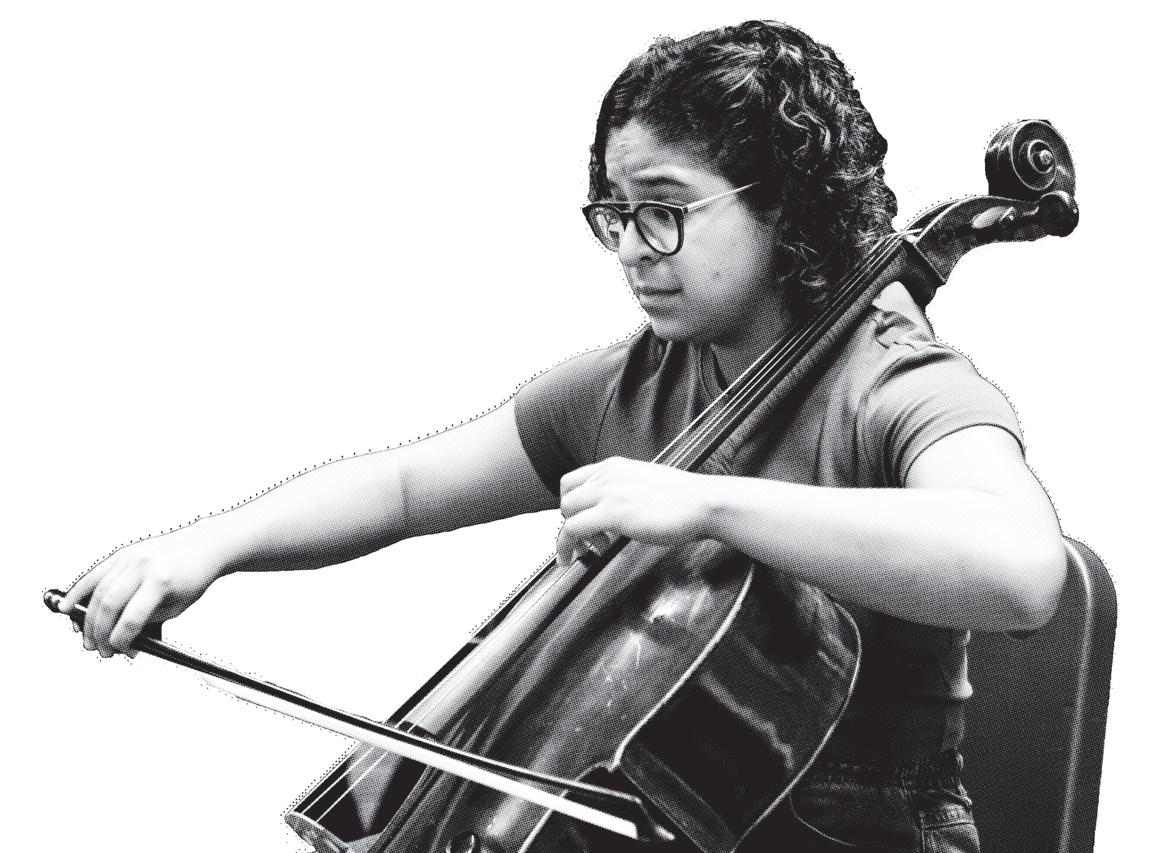

SMTD STUDENT FLEX SERIES
SMTD students have access to exclusive ticket sales for productions including plays, operas, dance shows, and more.
• $10 per ticket— over 20% off the standard student ticket price plus reduced fees
• Ticketed seats located on the main floor, closer to the action
• Priority ordering several weeks before individual ticket sales begin
• Exchange tickets up to 48 hours before the performance begins with no fee
Visit tickets.smtd.umich.edu to learn more!








 Leyla Dumke
Leyla Dumke

























 EVELYN MOUSIGIAN/Daily
EVELYN MOUSIGIAN/Daily




















